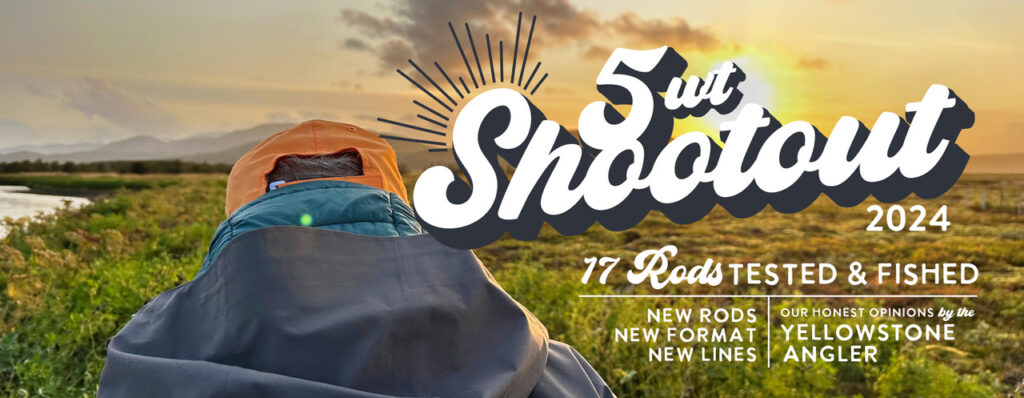
With more than ten new 5-weight fly rod models hitting the market since our 2020 5-Weight Shootout, we decided it was time to update our ratings of what rod manufacturers are currently producing. In this evaluation we weighed, deflected, cast, and fished each fly rod side-by-side to see how they compared. This comprehensive head-to-head analysis allows us to give you the most complete advice on how these 5-weights differed as well as which 5-weight rods to consider or purchase.
If you’ve been reading our Shootouts for a while, you know we are not about to pull our punches if we feel a rod manufacturer’s product falls short of its claimed qualities. We have always given you our honest opinions, which at the end of the day, are just that – our opinions. Both in terms of our criticism of rods, as well as our compliments, we simply call it the way we see it. Our credibility depends on it.
There are many approaches to rod design and construction and naturally, different anglers prefer different actions. However, we are able to describe and compare the actions of the rods we are reviewing by testing and casting them immediately side by side. In this Shootout, you will see our preferences align with faster action rods that have light swing weights. Your preference, (and casting style), might be different. As long we are able to identify how each rod’s action differs from the next, we have done our job. After that, it’s up to you.
We hope this Shootout will help you determine which rod is the right fit for you. While we have focused primarily on finding the best all-around 5-weight rods, you might be looking for a more specialized 5-weight, especially if you already own a 4, 5, or 6-weight. We think this Shootout will help you see through the manufacturers’ marketing hype and narrow your choices, whether for an all-around rod or one more suited to a specialized application.
There are a number of rods missing from the Shootout this year. This year we limited the Shootout to only rods we carry. Every fly rod manufacturer we carry was offered the opportunity to supply a rod for our testing. A number of them, nevertheless, chose not to participate, so the following rods are not included:
Echo Carbon XL
Echo Trout X
Sage Foundation
Scott Centric
St. Croix Evos
St. Croix Tecnica
T&T Avantt 2
TFO Legacy LK
TFO Axiom II
Winston Air 2
Winston Pure
Although we have not reviewed or rated these rods here, they are all available for sale on our website and at the shop. But if you are curious as to how any of these specific rods cast, just give us a call or swing by to try one. There is an excellent chance we have cast or fished it.
Like the rods we test, our Shootouts are constantly evolving. We listen to reader and customer feedback, read other reviews, and pay attention to comments and criticism on fly-fishing forums as well as receiving input from our editorial consultant, who is an avid and experienced fly angler.
This year we have addressed two issues that often arise in the feedback we receive: 1. It’s not fair to compare each rod using the same line, and 2. How can you tell the way a rod performs without actually fishing it? In addition to incorporating the use of different lines and fishing the rods, we added a few things in an attempt to make our Shootout better:
New Format Bullet Points
Most of you are familiar with our previous Shootouts and our scoring methodology. We have found that most readers want to get to the bottom line first. Accordingly, in keeping with our recent Shootouts, we are presenting our results first. If, however, you are unfamiliar with our Shootouts or would like to understand our testing and scoring methods, please scroll down or click here to read our Methodology and Scoring Section. Don’t overlook this section, however, since it contains many additional impressions and comparisons of the rods in this Shootout.
Our 5-Weight Shootout Results Summary
Overall Winner – Douglas Sky G
Best Powerful 5-Weight – G.Loomis NRX+
Best Feel for a 5-Weight – Douglas Sky G, Orvis Helios F, Scott Session
Best Mid-Priced 5-Weight – Guideline NT11
Best Inexpensive Tailwater 5-Weight – Grey’s Lance
Best Inexpensive Freestone 5-Weight – Fenwick Aetos
Most Accurate – G.Loomis Asquith
Best Tip Dampening – Orvis Helios F, Orvis Helios D
Best Streamer / Sink Tip 5-Weight – G.Loomis NRX+
Best Mid-Priced Streamer 5-Weight – G.Loomis IMX-PRO V2
Best Inexpensive Streamer 5-Weight – Fenwick Aetos
Biggest Grip (For Meathooks) – Fenwick Aetos, Hardy Marksman
Best Price – Grey’s Lance
Thinnest Grip (For Women / Children) – Grey’s Lance
Best Craftsmanship – G.Loomis Asquith
Best Warranty Policy – Douglas Sky G
Lightest Overall Weight – Guideline NT11
Lightest Swing Weight – Douglas Sky G
Best Heavy Nymph / Indicator 5-Weight – G.Loomis NRX+
Best 25′ Performance – Douglas Sky G, G.Loomis Asquith, G.Loomis NRX+LP, Guideline NT11
Best 35′ Performance – Douglas Sky G, G.Loomis Asquith, G.Loomis NRX+LP, Hardy Marksman
Best 45′ Performance – G.Loomis Asquith
Best 60′ Performance – G.Loomis NRX+
Best To Throw The Whole Line – G.Loomis NRX+
Slowest / Bamboo Like Feel – Scott Session
Most Likely To Become A Cult Classic – G.Loomis Asquith
Most Easily Recognized From Afar – Orvis Helios F, Orvis Helios D
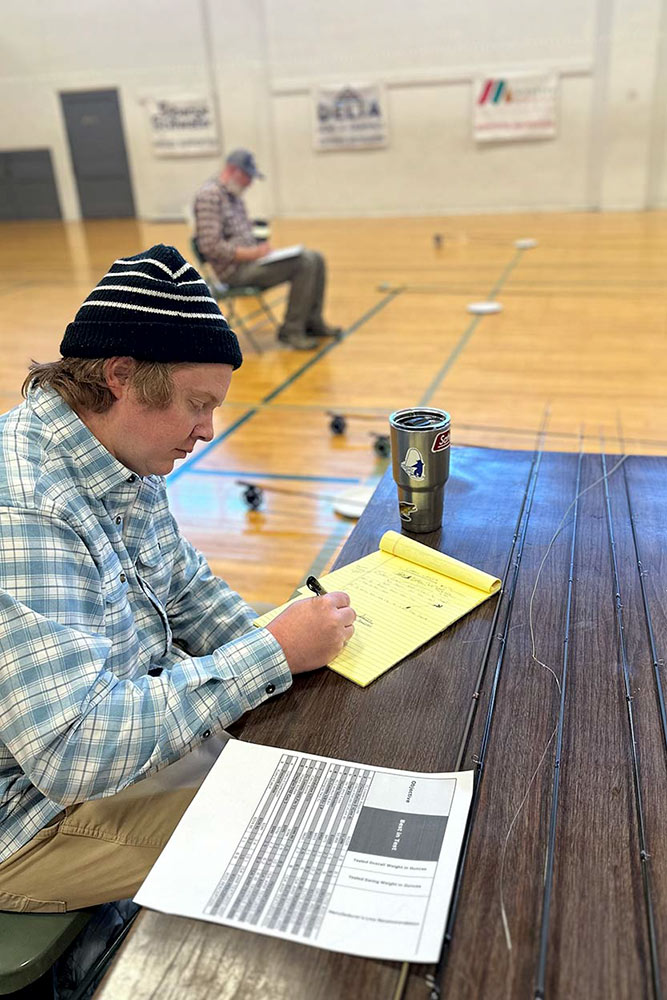
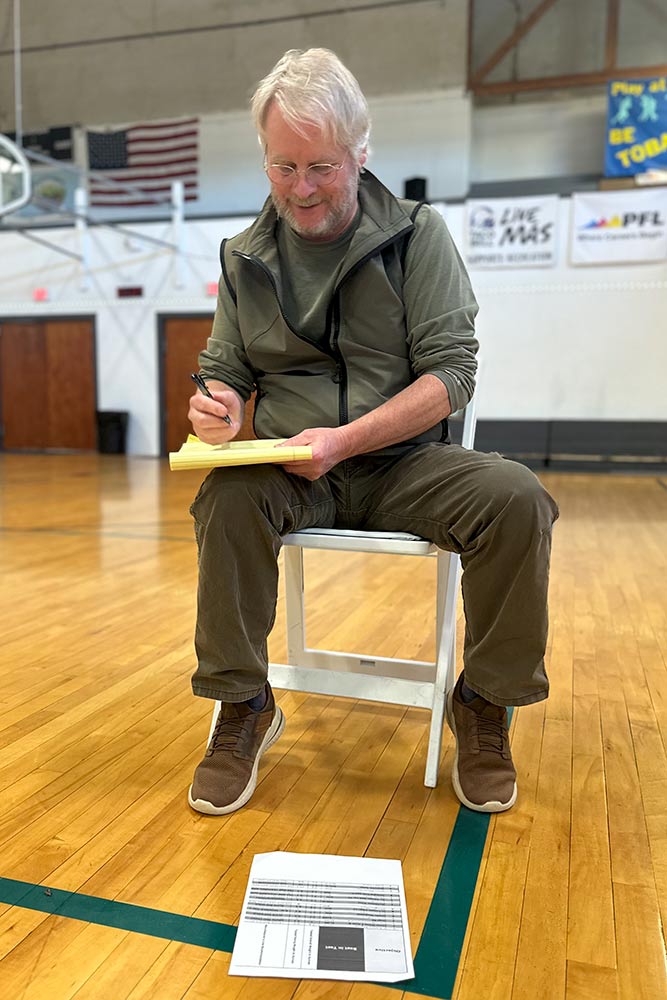


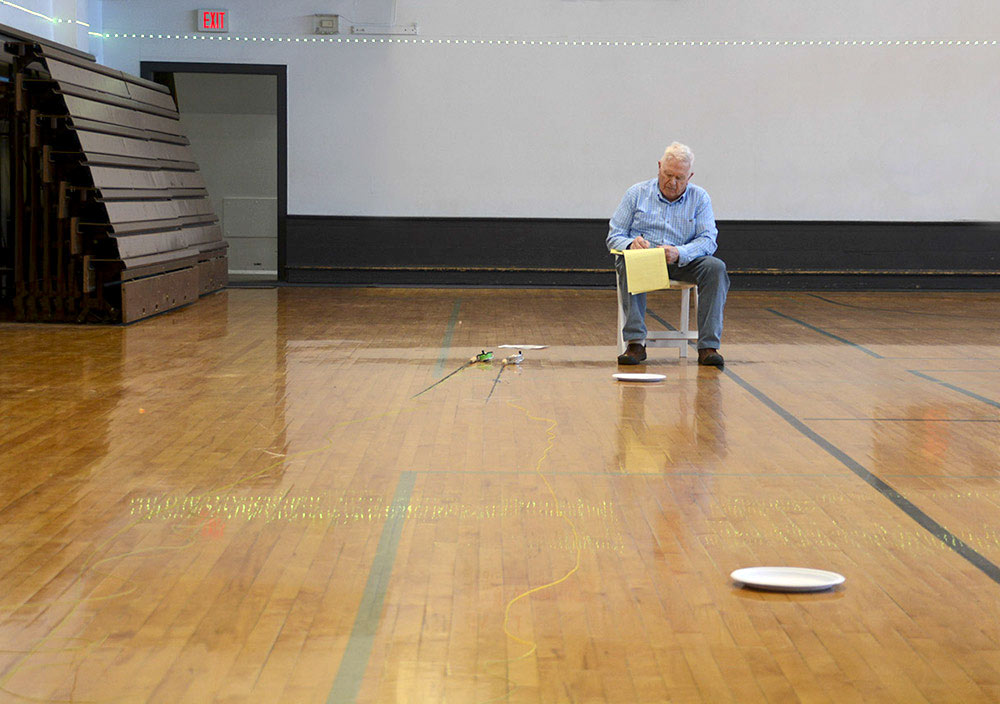
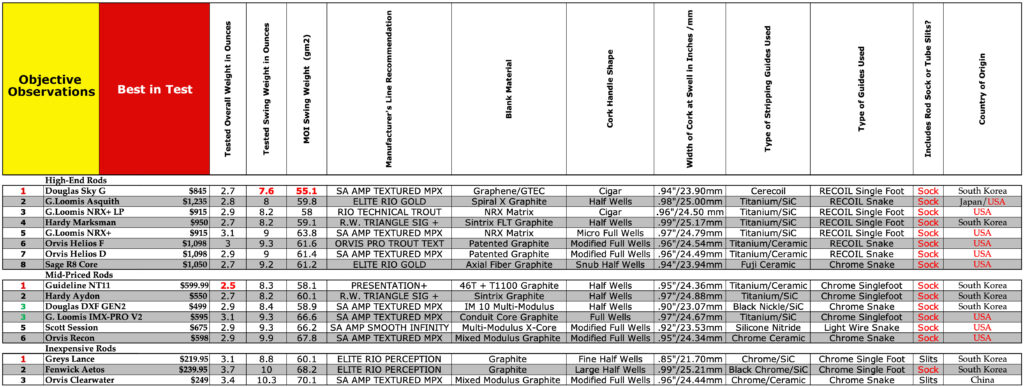

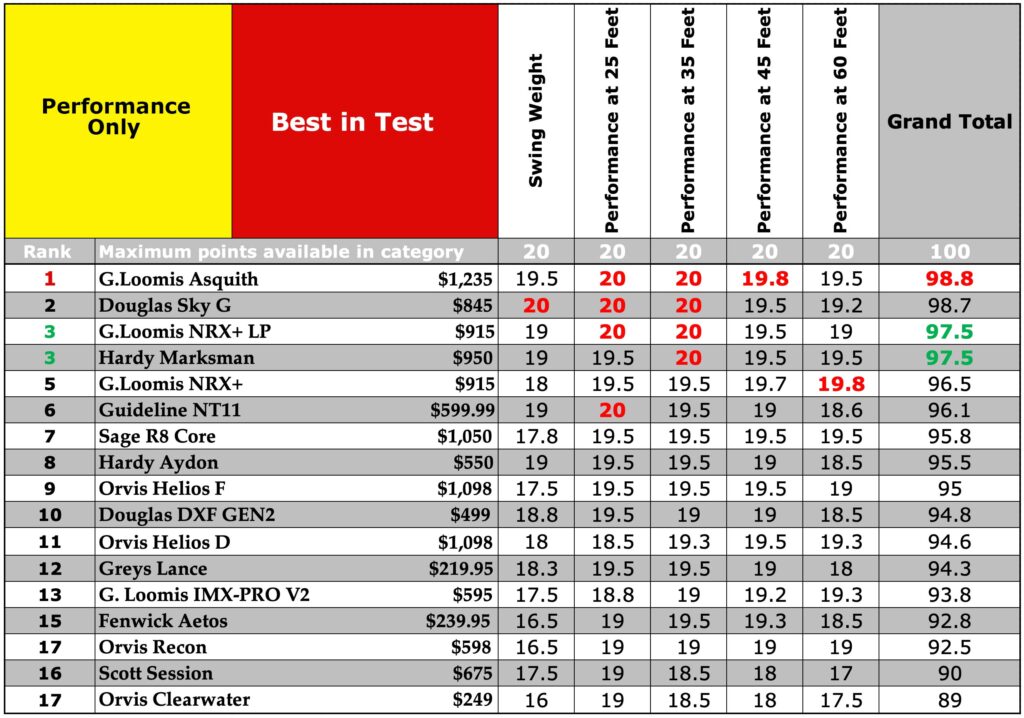


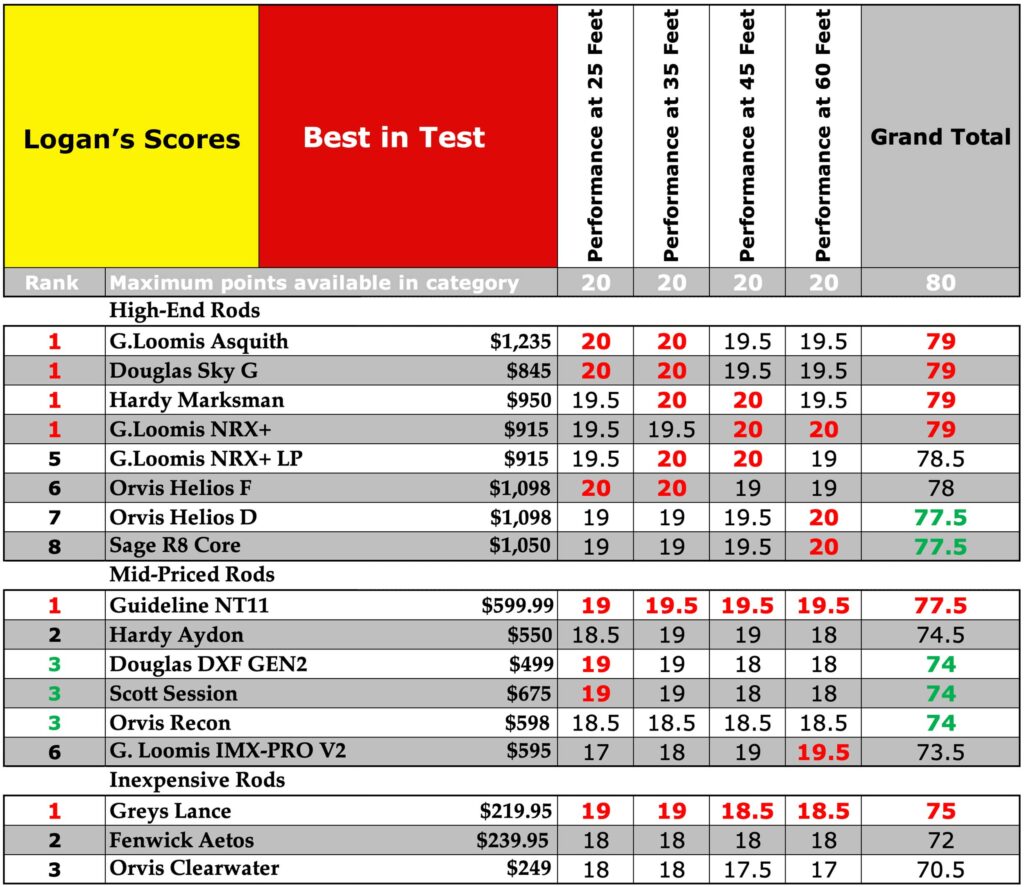
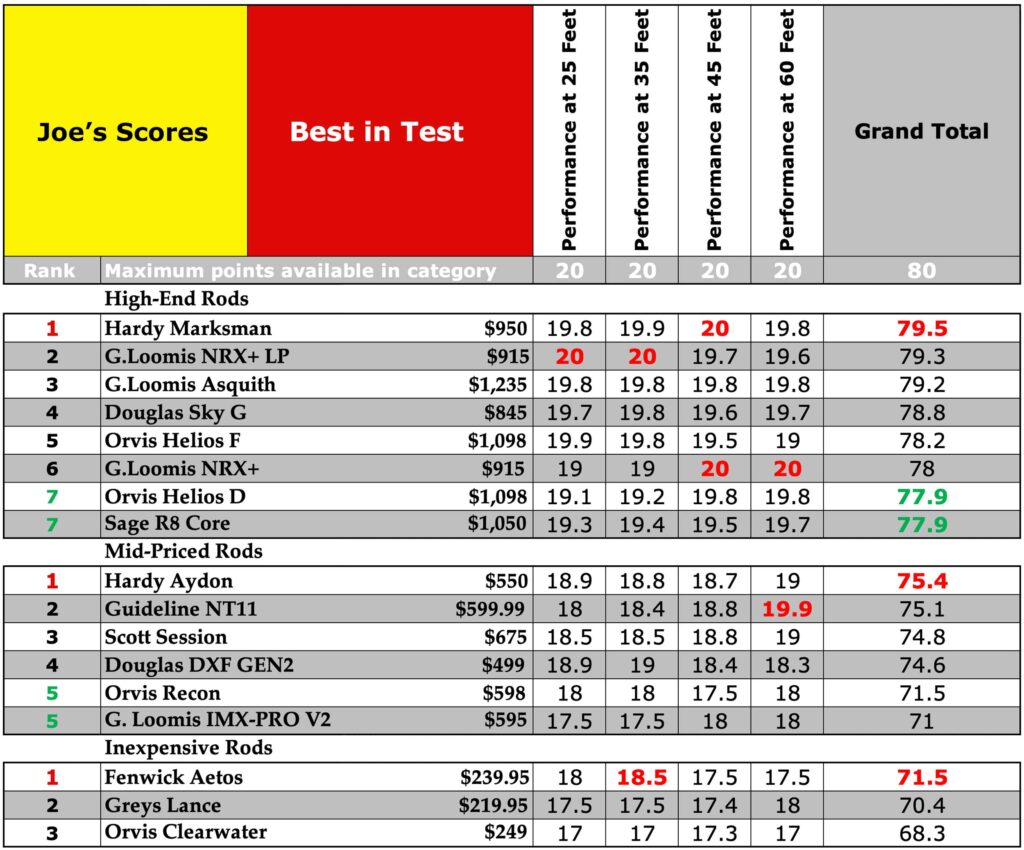
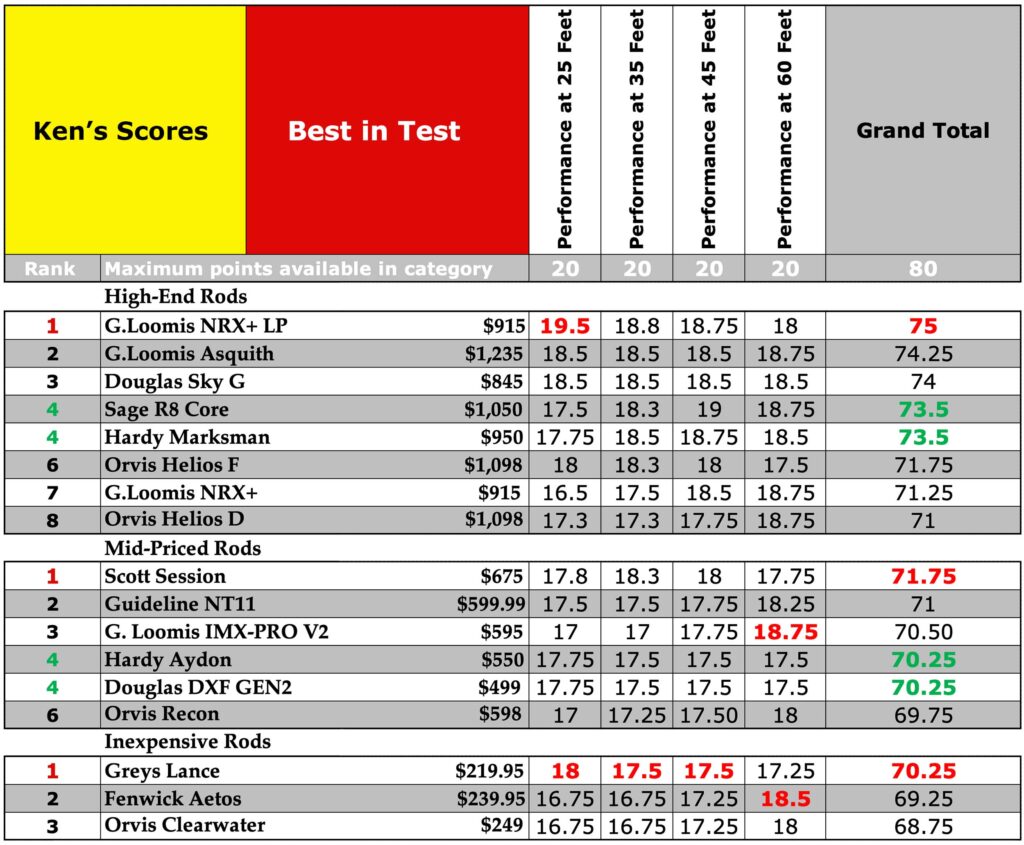
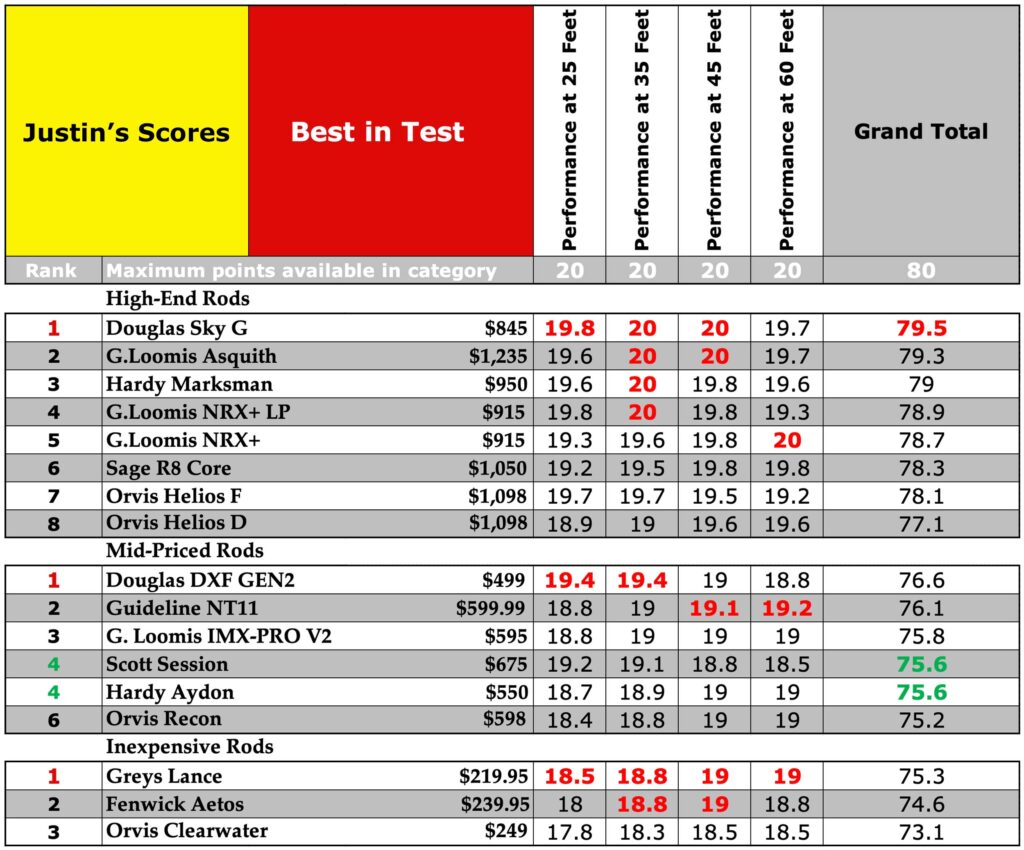


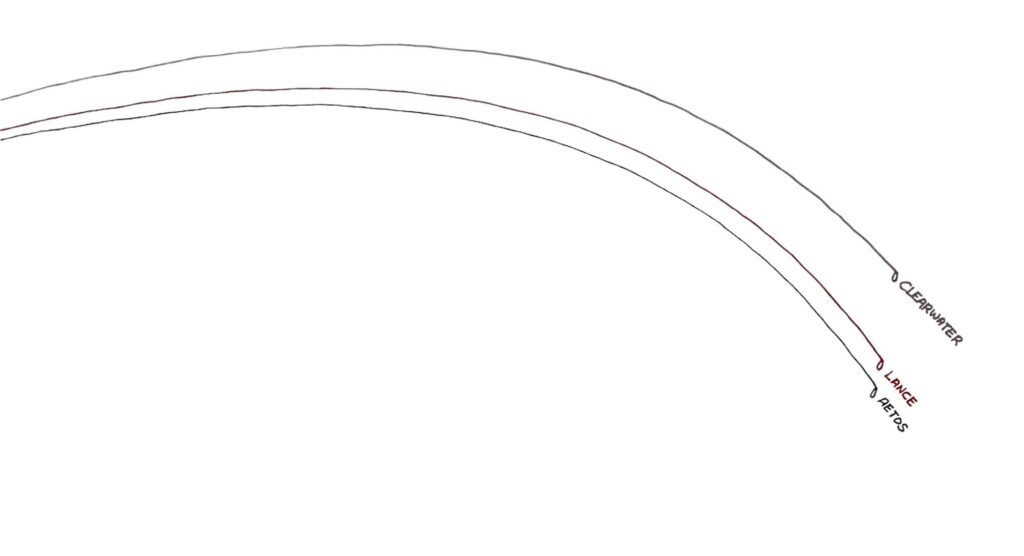

Once again, the Douglas Sky G is at the top of our current 5-weight rods, and for good reason. It gave us nearly perfect performance at the shorter distances and extremely good results right out to 45 feet. At the price of $845.00, it is hundreds of dollars less than our other competing 5-weight rods while providing better performance in most cases.
The Sky G has been my go-to 5-weight for many years and has never let me down. I love fishing it on the Missouri, where pods of big rainbows congregate. Often if I observe their rises long enough, a larger fish will reveal itself and the Sky G gives me the edge I need to make an accurate, precise cast. If my cast is too long, too short, or too far to either side another fish could eat my fly, jump around, and put the pod down for a while.
Having an accurate rod that has enough power to land a big 20″ rainbow gives me a lot of confidence to get the job done. The Sky G is also a great rod for sight nymphing, when the larger fish are not eating on the surface. The Sky G has the power to set the hook quickly and firmly, while the G’s softer tip protects my 6-7X tippet. If the wind picks up and blows the hatch away as it often does in Montana, I can fish hoppers tight to the undercut banks or even throw two small streamers, eliminating the need to bring along a second or third rod, which can be a pain.
This is the same Sky G that appeared in our 2020 5-weight Shootout. If you’re not familiar with our description of the development and construction of this rod, we have copied an insert from of our 2020 review in italics below – feel free to skip to the 2024 scores if you are familiar with it:
Fred Contaoi, the head rod designer for Douglas, took on the process of refining the original Sky G, resulting in this rod that produces the ultimate in casting presentation and accuracy. Fred modeled the Sky G in part on some of the other great 5-weights we liked, including the original G. Loomis NRX LP, which has good butt and mid-section power but has a softer tip section. In looking at the deflection board, the Sky G has lots of mid-section power but a softer tip than a lot of the other rods. Out on the lawn, we love how well we can cast short distances off the tip of the rod, with superb accuracy. But there is still plenty of mid-section power when needed.
According to Fred, the SKY G rods are composed using G-Tec platelets. Platelets are essentially building blocks that are microscopic in size. The platelets make up a small part of the resin matrix while offering substantial benefits in using less material and maintaining high integrity in linear and hoop strength, with added impact resistance. The combination of graphene materials and a new resin system is what Fred refers to as “G ARMOR.” These changes allow Douglas to build this SKY G with less material, resulting in a much lighter and stronger rod. This description seemed to check out, as the Sky G has the lightest swing weight of all the rods we tested. The SKY G is very quick to dampen and is very sensitive. It gave me a wonderful sense of feel, especially at short distances. The increased dampening and recovery also result in superior accuracy, which immediately impressed me when casting and comparing the SKY G to the other top 5-weight rods.
The SKY G is an attractive rod, finished in a dark gray color, with black wraps. The epoxy coatings are excellent. Three thin coats of epoxy are applied to the wraps, rather than a thick one-coat used by other manufacturers. Alignment marks on the sections are helpful and the rod size is noted too. The guide set is perfect, starting with one of the new cerecoil stripping guides that use a nickel titanium frame and a zerconia ring insert designed to resist separating from the frame as it flexes. Recoil nickel titanium, flexible one-foot guides are used the rest of the way. These single foot guides are lighter than snake guides, but have proven to be extremely reliable and rarely break. A cigar shaped handle is used with the swell a little more forward than most. A stack of thin cork rings is used and the quality is close to perfect. Thin contrasting rubber/cork rings are added top and bottom for increased durability, ensuring you can pass this rod down to your grandkids someday and the cork edges will still be intact. The gray anodized double up-locking skeleton reel seat uses nylon washers on the rings that give a very secure lock up. A burl blackwood insert is used. One of the best reel seats we have seen.
George’s 2024 Score: 78.7 out of 80
Casting Notes at 25 Feet: 20 out of 20
I love the accuracy I’m getting, combined with lots of feel.
Casting Notes at 35 Feet: 20 out of 20
Excellent accuracy again with amazing feel.
Casting Notes at 45 Feet: 19.5 out of 20
Also awesome. Not quite as good as the Asquith, but not much daylight between them.
Casting Notes at 60 Feet: 19.2 out of 20
Only out long does the accuracy fall off.
Like the Sky G, the Asquith has been around for a while, I have been fishing mine for nearly 7 years now. I turn to my Asquith 9’#5 whenever I’m looking for a little more power over my Sky G. This could be due to the wind, but more often it has to do with the type of flies I will be fishing that day. If I’m headed to the Yellowstone or Madison, I’m likely planning on throwing a handful of larger dries like hoppers and stoneflies along with smaller pmd’s and caddis. I’m always looking for rising fish in the foam lines and eddies but if it is not in the cards I like throwing two hoppers. On days when the fish refuse to look up, I’ll switch to a stonefly dry with a stonefly nymph dropper. The guides all love throwing this rig and I can see why, it works well and can cover a variety of different depths depending on how you mend or drag it. No question, the Asquith is the best rod I’ve ever fished for this type of fishing. The beauty with the Asquith is that if the wind dies down, the clouds come out, and pmd’s start coming off, I have an elite rod for technical dry fly fishing. I’m not sure if G. Loomis will be able to develop anything that can top the Asquith.
If you’re not familiar with our 2020 description of the development and construction of this rod, we are supplying a summary below in italics again for you to read or skip to to the 2024 scores:
I have loved the Asquith rods since their introduction. These rods are both powerful and delicate when they need to be, especially in the 5-weight. Steve Rajeff designed the tapers and mandrels at G. Loomis but the actual blanks are rolled and finished at the Shimano factory in Japan. Once the blanks are received at G. Loomis, the rods are finished in Woodland, WA.
Loomis calls the construction Spiral-X technology and it is unique to Loomis. Spiral-X technology is a complex three-step process. Shimano has developed a special graphite tape, called infinity tape, which is wrapped on the mandrel on a 45-degree axis. Next, a layer of “muscle carbon” is wrapped on in a conventional manner. The final step is another wrap of the infinity tape, but at an opposing 90-degree angle to the first, so that the infinity tape forms an “X” pattern.
The beauty of this process is that it uses 15-20% less graphite to get the exact same strength as the original NRX rods, which we know from experience are stronger than any other rods we have used. Another benefit of Spiral-X technology is that it reduces any twist in the blanks, and more importantly, reduces ovalization as the rod bends. This gives an angler more feel combined with an enormous amount of reserve power. About the only drawback of the Asquith is the price. At $1235.00, it is significantly more expensive than the other top rods we tested.
The Asquith it a lovely rod, with extremely good craftsmanship. I love how the dark green finish sparkles in the sunlight. The wraps are done in black and finished perfectly. On the 9’#5 Asquith, one single stripping guide is used, along with nickel/titanium snake guides that are flexible, and will never break.The cork handle is comprised of a stack of narrow cork rings, with almost no imperfections. A comfortable half wells shape is used with the swell a little forward of the middle of the grip. Lastly, the reel seat is a beautiful combination of narrow rings of bamboo, with a single uplocking ring that locks up perfectly and securely.
We were blown away by the Asquith’s performance. It was nearly perfect at every distance with the highest scores at 25, 35, and 45 feet. At 60 feet, only the Loomis NRX+ was better. Looking back at my casting only scores at the various distances, the Asquith outscored the Sky G. Overall the Asquith lost points to the Sky G, mostly due to the price. I’ve used Asquith rods for a lot of my saltwater fishing, with a 9 foot #8 for bonefish, snook and redfish, and a 9 foot #11 for tarpon. They always impress in their casting accuracy and fish fighting ability.
George’s 2024 Score: 79.3 out of 80
Casting Notes at 25 Feet: 20 out of 20
Impressive accuracy combined with a lot of feel.
Casting Notes at 35 Feet: 20 out of 20
Nearly prefect accuracy again. I can put the fly right where I want.
Casting Notes at 45 Feet: 19.8 out of 20
The best accuracy that I got at this distance with any rod. Lots of feel too.
Casting Notes at 60 Feet: 19.5 out of 20
Only the NRX+ was better at longer distances.
This is the same rod we reviewed in 2020 and much of the construction and materials are described in the review of the NRX+. I’ve added some further notes about the NRX+ LP below.
I’ve always liked the G. Loomis rods and the NRX+ LP is another outstanding example of a rod that can do everything you want a 5-weight rod to do. It was especially good at short to medium distances on the spring creeks, and only at long range did the performance fall off slightly. This would be a great rod for nearly all anglers, that are looking for a rod that can make delicate presentations in close but has the power to reach out and make those longer casts very easy.
This rod has good butt and mid-section power which come into play when an angler needs to reach out at longer distances. So what you have here is a wonderful dry fly rod but one that can also chuck some streamers when you need to. Another great all-around rod from G. Loomis! I felt that the NRX+ LP gave me just a little more power than the Sky G, which I appreciated at times in the Livingston wind.
Like the other G. Loomis rods, this is a handsome rod with extremely good craftsmanship. The color is a dark olive color, with contrasting brown wraps, trimmed in white on the butt section. One small titanium SiC stripping guide is used, with the rest of the guides being my favorite Recoil single foot guides that will bend but not break. The epoxy coatings over the guides were nicely done. G. Loomis gives you a hook keeper just above the handle, which is handy. The cork handle is a comfortable cigar style, and comprised of a stack of very high quality thin cork rings. One darker rubber/cork ring at the base of the handle looks good. The reel seat is a double uplocking affair, with a handsome walnut burl wood insert.
George’s 2024 Score: 78.5 out of 80
Casting Notes at 25 Feet: 20 out of 20
Impressive! Making short casts with great accuracy was easy with this rod.
Casting Notes at 35 Feet: 20 out of 20
Slightly heavier than some of the top rods, but it was stable with wonderful accuracy.
Casting Notes at 45 Feet: 19.5 out of 20
Awesome at mid-distance and I’m getting great accuracy. Definitely one of the very best rods at 45 feet.
Casting Notes at 60 Feet: 19 out of 20
Finally at long range, the accuracy fell off. I felt that other rods like the NRX+, Asquith and Marksman were definitely better.

The Marksman is Hardy’s latest premium rod, replacing their Ultralite. When I picked up this rod I was impressed at how light it is compared to others. Howard Croston, Hardy’s rod designer, not only knows a lot about rod design, but he’s the top angler on England’s International fly-fishing team, which has won the title a number of times. Howard is a terrific caster and one of the very best anglers I’ve fished with. Out on the lawn casting, I’ve been impressed with how tight Howard’s loops were. Howard has come up with several great rods that I have liked – the Zenith, the Zephrus, and the Ultralite. The Marksman is another terrific addition to these other rods.
The Marksman, like the Zephrus, is very good at all distances, but especially good at 25-35 feet, which I find myself fishing most of the time. This rod has a strong butt section and you can lean on it when casting longer distances too. On the deflection board, the butt and mid-section were much the same as the Loomis Asquith and the Orvis Helios D, but with a slightly softer tip. For fun, we deflected an old Hardy Zenith 9’#5 and found it was identical to the Marksman! But in weighing the rods, the Marksman was lighter in both overall weight and swing weight compared to the Zenith. The Marksman is one of the very lightest we tested in swing weight – in a tie with the Asquith and Hardy’s sibling, the Aydon.
I liked everything about this rod except the reel seat. It worked well in the end but was a little hard to figure out at first. Unlike other rods, the reel doesn’t sit on the wood insert, but rather slightly above it. Perhaps this is a way to avoid the wood from getting a water mark over time, but I always take my rod and reel apart at the end of the day. As such, the Marksman’s score in reel seat functionality was slightly lower than other top rods.
The Marksman is a sharp looking rod that you will be proud to show off to friends. The blank color is a matte bronze, with brown wraps, trimmed in metallic green. Alignment dots at the ferrules are helpful. Hardy utilizes a modified spigot ferrule system that allows for a larger surface area of contact between the sections, which distributes casting energy and fish fighting stress more evenly. It also accounts for less overlap at the ferrules, keeping the rod’s taper true to form.
The butt section above the handle is gray with a nice x-wrap pattern. A hook keeper is fitted just above the cork handle. The comfortable half wells design handle is comprised of another stack of thin diameter cork rings with almost no imperfections. The reel seat is black anodized, double uplocking, with an attractive burl wood insert. Metal ferrule plugs are included which are a nice traditional touch, although mine have lived in the rod sock pocket since day one.
I liked the guide set-up. A hook keeper is fitted just above the handle, then one titanium SIC stripping guide, followed with excellent black colored single foot and flexible nickel/titanium guides. Hardy rods are built in South Korea, in the same factory as Loop, Guideline, Taylor, and Fenwick rods. Douglas has moved to a separate factory there.
George’s 2024 Score: 78.5 out of 80
Casting Notes at 25 Feet: 19.5 out of 20
I was tempted to give it a 20 but the Asquith and Sky G were definitely better.
Casting Notes at 35 Feet: 20 out of 20
Now it does rate a perfect score. Just about perfect!
Casting Notes at 45 Feet: 19.5 out of 20
Wonderful feel and accuracy, only edged out by the Asquith.
Casting Notes at 60 Feet: 19.5 out of 20
Again, one of the very best rods in our shootout at long range.

With nicknames slung around the office like, the “big gun,” the “rocket ship,” and “beast mode” one would assume the NRX+ does not perform well in close with smaller dries. If I applied the same exact power and casting stroke as I did with the Sky G or Asquith, the NRX+ became a plate smacking whack-a-mole mallet. But to my surprise, I found if I used a little more wrist action and stopped my casting stroke so the leader straightened out above the plate, I could still achieve very accurate, light presentations. This says a lot for the stiffest rod in our Shootout, but the key lies in its relatively softer tip, which gives the rod better feel at all distances. The softer tip is also relatively light in swing weight, especially for a power 5-weight.
If you are the type of angler that likes to snipe rising fish from 50-60 feet away, (from necessity of not spooking them, or perhaps you have become bored with normal fishing distances and appreciate a new challenge), the NRX+ is for you. It is also the best streamer 9’#5 rod I have ever fished. The NRX+ is another rod we reviewed in our 2020 5-weight Shootout. If you’re not familiar with our description of the development and construction of this rod, we have copy it in in italics below.
Steve Rajeff, (now retired) designed the NRX+ rods. He was a 14 time all-around world champion caster, and his pedigree shows in the re-design of his original NRX rods. The NRX rods were great rods, but the new NRX+ rods are even better. They are lighter, stronger, and dampen better than anything G. Loomis has given us in the past.
In upgrading the NRX rods, Steve utilized a blend of three things: Mega Modulus+ Graphite, GL8 Resin, and Multi-Taper Design. As Steve explained, the new Mega Modulus+ graphite fiber is slightly higher in modulus but has a much higher strain rating. This makes the blank much stronger under a “lifting load” with less overall material used. G. Loomis has built some of the toughest rods we’ve ever fished and it takes a lot to break one. Knowing the new NRX+ is even tougher than the old NRX is great news!
This NRX+ is one of the very stiffest rods in our Shootout. When compared with the NRX+ LP, the LP is much softer, especially in the tip. The NRX+ can be an advantage in the wind, especially if you want a 5-weight rod that can throw streamers. The additional stiffness of the NRX+ is also a big help if you are fishing nymph rigs with an indicator and a lot of split shot. Casting long bombs with this rod is a piece of cake, and it still feels light in hand.
The NRX+ rods differ from the NRX+ LP in color. The NRX+ rods are an attractive deep steel gray color with darker midnight blue wraps, trimmed in lighter blue and silver on the butt. Another difference from the NRX+LP rods is that the cork handle on the NRX+ is a full wells style with a pronounced swell in the middle of the grip. It felt great to me, especially when casting longer distances. Loomis uses a stack of very high-quality thin cork rings with one rubber/cork ring at the bottom of the flare to promote durability. A dark gray anodized aluminum, double uplocking seat is used that holds the reel very securely. The insert is epoxy-impregnated wood in a deep brown color.
For guides, a single, extremely light stripping guide is used, with a titanium frame with a very thin wall SiC ring. The rest of the guides are the finest, flexible, nickel/titanium one-foot guides that you will never break. A small hook keeper is used, just above the cork. The epoxy coatings on all the guides are excellent.
George’s 2024 Score: 78.50 out of 80
Casting Notes at 25 Feet: 19.5 out of 20
Surprisingly accurate despite the stiffness. As good as the Marksman, but not nearly as good as the Sky or Asquith.
Casting Notes at 35 Feet: 19.5 out of 20
Again, very good accuracy that matched the Orvis Helios rods, but the NRX+ LP along with the Sky G, and Asquith were definitely better.
Casting Notes at 45 Feet: 19.7 out of 20
A rocket ship for sure! Only the lighter Asquith felt better.
Casting Notes at 60 Feet: 19.8 out of 20
The power of this rod produced the best long-distance results of all the rods for me. If you want a 5-weight rod that will throw long with ease, this is your rod!


The bottom line: The Helios F is a fantastic all-around rod, and right up there with the best of them. Sometimes a marketing campaign can be so strong it overshadows its own product.
Orvis made some big changes to their Helios rods this year and rolled out an advertising campaign claiming that these new Helios rods are lighter and four times more accurate than their earlier rods. They further claimed that these new Helios rods are the most accurate rods in the world. We’ve done our comparisons, and we beg to differ.
We were not going to buy all this Orvis hype without comparing their new rods to the contenders. They may be better than the Helios 3 rods, but how did they stack up to the best rods in our Shootout like the G. Loomis Asquith, NRX+LP, Douglas Sky G or the Hardy Marksman? The short answer is not quite as good in a number of ways.
We have to give Orvis credit for their attempt to improve these Helios rods but here is what we found in our own testing. We weighed the old Helios 3F at 2.9 oz. and the new gen 4 Helios F at 3.0 oz. (in overall weight). Then we weighed their swing weight, using our proven method, and the old Helios F came in at 8.8 ounces, while the new Helios F was 9.3 ounces! The Helios 3D and gen 4 Helios D came in at the same overall weight – 2.9 oz. In swing weight, however, the old Helios D weighed 8.6 oz. and the new Helios D weighed 9.0 oz.
We called Orvis after noticing these weight discrepancies and shared our concerns. We learned that Orvis measures swing weight differently than the method we use. Orvis uses a torsion testing meter, in which the reel seat becomes the fulcrum for the point of weighing each rod. Our method makes the center where you’d naturally grab the cork grip the fulcrum. The different methods account for the different weights, although Orvis did not share their weights with us. Our method is by no means scientific, but it is one you can do at home, and we feel more representative of the true swing weight, since you grip the rod by the cork grip when fishing and not the reel seat.
For as much criticism as we have dished out to Orvis’ gorilla marketing, to be sure, their new Helios F is the best all-around rod they have ever made and a definite improvement over the previous H3F.
I’ve never been a fan of the white label on the butt section of these Helios rods. We know the reason Orvis does this – you can tell that the rod is an Orvis Helios at a long distance and especially in all the fishing videos found on youtube or Instagram. I can respect what Orvis is doing and we’re sure it has increased the visibility and sales of the Helios rods.
The new Helios F is finished in a dark olive color, with complementary olive wraps. The new rod still has a white label above the handle, but now it is two tone – white and light gray. One huge stripping guide is used, and the rest of the guides are the good recoil snake guides that will bend but not break. I prefer the flexible single foot guides but these snake guides work fine. The guides are wrapped with a complementary olive color but I felt that the coatings were a bit heavy. Alignment dots at the ferrules are helpful. The cork handle is called a modified full wells, with a comfortable swell in the middle. The quality of the cork was excellent. I would have liked to see a hook keeper above the cork handle. The silver uplocking reel seat works well with a fairly large locking ring that incorporates a nylon ring at the front side to provide a secure lock up. A nice piece of gray burl wood is used as a spacer.
George’s 2024 Score: 77.5 out 80
Casting Notes at 25 Feet: 19.5 out of 20
Wonderful feel and excellent accuracy. Only the Asquith, Sky G and NRX+LP were better. This rod is fun to cast in close.
Casting Notes at 35 Feet: 19.5 out of 20
Again, great feel and superb accuracy. One of the best rods at this distance in our Shootout, but still behind our top four rods.
Casting Notes at 45 Feet: 19.5 out of 20
Good feel and it was easy to get good accuracy without a double haul.
Casting Notes at 60 Feet: 19 out of 20
Finally, the softness of the Helios F hampers my accuracy out long.

[See our comments about the Helios F marketing and swing weight calculation, which apply equally here].
The Orvis Helios D, (D for distance) is quite similar in appearance to the Helios F, but in a different color – dark gray. I can see the difference immediately when looking at the butt section, which is noticeably larger in diameter. On our deflection board, the profile of the D is pretty close to the Loomis Asquith, with the Loomis NRX+ being overall a lot stiffer, in both the mid-section and tip.
As mentioned in my comments about the Helios F, Orvis did a lot of work to improve both new Helios rods. Orvis claims the new rods are lighter and are four times more accurate than their original rods. They also claim that these new Helios rods are the most accurate rods in the world, but we didn’t find this to be true. These Helios rods are better than the original ones, but how did they stack up to the best rods in our shootout like the G. Loomis Asquith, NRX+LP, Douglas Sky G or the Hardy Marksman? The short answer is that we felt that the other top rods were better, and in many instances, more accurate.
It’s not that the Orvis Helios rods are bad rods – they are actually very good rods and only small differences separate them from the best rods in our Shootout. The Helios D tracks very well, and the Orvis improvements show up here for sure. But in a 5-weight, most experienced anglers are likely to prefer the Helios F.
The color of the blank on the Helios D is a very dark gray, almost black. The wraps are black. The guides start out with a humongous (for fresh water) titanium/ceramic stripping guide, and the rest of the guides are the good Recoil snake guides, which are flexible but will never break. The finish on the wraps was nearly perfect and better than what we saw on the Helios F. Neither the Helios D or Helios F use a hook keeper above the cork handle, something I miss.
The cork handle proved to be very comfortable, with a wider middle, tapered off on either end. Orvis calls this a modified half wells. The grip is a stack of smaller cork rings with absolutely no imperfections. The skeleton reel seat was similar to the Helios F, but in black with a nice looking gray burl wood insert. I especially like the easy to tighten, wide uplocking ring with a plastic ring, which gives a good solid lockup on your reel.
George’s 2024 Score: 76.6 out of 80
Casting Notes at 25 Feet: 18.5 out of 20
As you might expect, the feel was not too good in close – the Helios F was far better.
Casting Notes at 35 Feet: 19.3 out of 20
Now I’m getting good accuracy and feel but our four top rods were better.
Casting Notes at 45 Feet: 19.5 out of 20
Nice feel and very good accuracy. Only the Asquith and NRX+ were better.
Casting Notes at 60 Feet: 19.3 out of 20
For some reason I felt that the Helios D struggled at distance compared to the previous H3D.

The R8 Core had a stiffer tip than most other rods and although it performed well, other rods like the Asquith and Sky G had a lot more feel, especially in close. The R8 Core is another very good rod from Sage, one that reminds me a lot of their popular XP or ONE. We actually deflected a 9’#5 Sage ONE and found the deflection to be identical to the R8. When we weighed the ONE however, the R8 was lighter in both overall and swing weights.
Anglers that want a powerful all-around rod will love this new R8 Core. There are other rods here that are better in close, but at medium to longer distances, the R8 Core was accurate with tons of power on tap. If you are looking for a rod that won’t struggle in the wind, the R8 could be your rod, especially if you are doing a lot of nymph fishing and even throwing some smaller streamers.
This rod was among the heaviest in swing weight for High-End rods. Sage uses larger and heavier guides on this 5-weight rod than most other manufacturers. When many of the other rod makers are using light, flexible single foot guides, Sage sticks to standard snake guides and a larger and heavier stripping guide. All this weight slows down the action and I can feel this extra weight compared to the other top rods.
Like past Sage rods, the overall quality is excellent. The blank itself is a dark greenish gray, which Sage calls silver pine. The wraps are a complementary gray color with some white and lighter gray trim wraps on the butt section. The cork handle and reel seat are excellent. One of the most comfortable cork handles, Sage builds this with a series of small width cork rings with no imperfections. They call the shape a snub half wells – pretty much straight with a little smaller swell at the top and a slight flare out to the reel seat. The reel seat is a skeleton seat with dark gray hardware that complements the color of the blank. The side opposite where the reel fits is marked with the size of the rod (5). A single uplocking ring is used that has a nylon facing that provided a secure lock up. A dark brown wood insert is used.
George’s 2024 Score: 78 out of 80
Casting Notes at 25 Feet: 19.5 out of 20
I’m getting good accuracy but not as much feel as I’m getting with the Sky G or the Asquith.
Casting Notes at 35 Feet: 19.5 out of 20
Again, a lack of feel but the accuracy was excellent.
Casting Notes at 45 Feet: 19.5 out of 20
This rod casts very well out long, one of the best rods tested.
Casting Notes at 60 Feet: 19.5 out of 20
Now the stiffness helps produce very tight loops and very good accuracy.
Before diving into our analysis of the NT11, First, some background on how we connected with Guideline. Guideline is a Swedish company, but their rods are built in Korea, like others. Guideline came to us last year to see if we were interested in carrying their rods. Since they were off our radar, our answer was no, we already carry too many rod brands. But they were persistent and asked if they could show us a rod or two and we agreed. Our first impression of the NT11 was a good one! It was extremely light, coupled with ample power and excellent feel. Guideline soon asked to be included in our next 5-weight Shootout, which we replied maybe, (since this year we were only including rods that we sell). Long story short, after comparing the NT11 9’#5 and finding it to be one of the best mid-priced rods we have ever tested, we now carry Guideline rods!
After seeing how well this rod performed, we felt that the price makes it a bargain as it could have been priced hundreds of dollars higher. Casting scores were equal to the Orvis Helios F! This rod is designed with a powerful mid-flex action. It has one of the lowest blank weights. It is nice and light in hand and on our deflection board, it is quite similar to the Helios F. Making delicate presentations with this rod was easy, and it had plenty of power to reach out when needed. It proved to be a nice rod to fish dry flies with and was especially accurate, but gave a nice delicate delivery.
This is a very good- looking rod! The blank is finished in a satin gray, with ruby colored wraps. The guide setup starts with a titanium frame stripping guide, followed up with hard chrome single foot guides. The guides on the tip section seem quite small but they worked well. I wish they had given us a hook keeper ahead of the cork handle. The shape of the handle is a half wells, a little thinner than most, but very comfortable. They use flor grade cork and the handle is a series of thin cork rings with no imperfections. A good looking, uplocking reel seat is fitted – dark gray with some red trim. Just one uplocking ring is used but it seems to work fine. A handsome dark brown burl wood insert is used.
George’s 2024 Score: 77.1 out of 80
Casting Notes at 25 Feet: 20 out of 20
Wow, I was impressed at such good accuracy, combined with a delicate delivery in close.
Casting Notes at 35 Feet: 19.5 out of 20
Again, an impressive performance at closer distances that you fish at a lot of the time.
Casting Notes at 45 Feet: 19 out of 20
Enough butt power to carry a nice tight loop, and put the fly on target.
Casting Notes at 60 Feet: 18.6 out of 20
Only at long distance did the NT11’s softer tip struggle, but still acceptable accuracy.
Here is another nice rod from Howard Croston, Hardy’s rod designer.The Hardy Aydon had a softer mid-section on our deflection board than a lot of rods but would make a good dry fly rod at a much lower price than the Marksman. There is a lot to like about this rod. Its attractive good looks and the nice performance at shorter distances will make anglers happy. This rod performed exceptionally well in close, fishing dry flies. It was easy to roll cast and mend while fishing nymphs. And it will even throw streamers decently when needed.
This is another good-looking rod from Hardy, finished in a dark olive color with complementary olive wraps. The guide set up starts out with a hook keeper- that I liked, just above the handle. A Sic stripping guide is fitted followed with hard chrome single foot guides. The epoxy coating over the wraps was good but a little heavy on some. The half wells cork handle tapers slightly towards the front, with a comfortable swell under my palm. The cork rings are series of small width, very high-quality rings with no imperfections. Hardy uses a black skeleton double uplocking reel seat that I felt worked well. A nice-looking gray wood burl insert is used.
George’s 2024 Score: 76.5 out of 80
Casting Notes at 25 Feet: 19.5 out of 20
Very good accuracy in close, with a good amount of feel.
Casting Notes at 35 Feet: 19.5 out of 20
Again, nice accuracy and feel at shorter distances.
Casting Notes at 45 Feet: 19 out of 20
Now the softness is hurting, and my loops are not as tight.
Casting Notes at 60 Feet: 18.5 out of 20
The softer mid-section is making this rod harder for me to cast at long distances, especially if there is any wind.

The Douglas DXF Gen 2, is another good rod that has been improved. We have always liked the DXF and this new edition casts great, especially at shorter distances. Only at long range did the performance fall off. Here is another good rod that can do it all at a reasonable price. Like the other Douglas rods this is built in Korea and the overall craftsmanship is excellent.
This is another rod that performs well with both nymphs and dries, and one that will also handle fishing smaller streamers. It proved to be easy to cast, even using two nymphs and an indicator. This is one of the softer rods in the Mid-Priced rods group, and out long it suffers from lacking the power of the stiffer-tipped rods.
The color of the blank is dark green that sparkles in the sunlight. The guide wraps are black, trimmed with some lighter green on the butt and at the ferrules. The finish on the guides is good. Alignment dots are helpful at the ferrules. Guides start with a hook keeper just above the cork handle. A dark gray SIC stripping guide is used, followed by dark colored hard chrome snake guides.
One of the few faults I found with the DXF is the cork handle. It is a half wells design and about the right size, but the quality of the cork rings is not very good and shows a lot of filler. Thin rubber/cork rings are used at the top and bottom of the handle for durability, which I do like for durability. The locking rings worked well, faced with a nylon bushing. While the reel seat could be fancier, functionality-wise it is one of my favorites in the Shootout.
George’s 2024 Score: 76 out of 80
Casting Notes at 25 Feet: 19.5 out of 20
One of the better performing rods for me in close. Good feel and accuracy but couldn’t match the NT11 or Aydon at short distances.
Casting Notes at 35 Feet: 19 out of 20
Nicely matched power and presentation, and a pleasure to cast.
Casting Notes at 45 Feet: 19 out of 20
At longer distances the performance fell off a bit, but still very good.
Casting Notes at 60 Feet: 18.5 out of 20
Now at long range the more powerful rods are better.

Loomis made some changes to their IMX-Pro, so they are calling this the V2, or Version 2. The tip is a little less stiff, but it is still a very powerful rod, and almost more suited to a 6-weight line than a 5.
This new IMX Pro V2 may not be as good as some of the other rods for fishing dries, but it is a wonderful rod for fishing nymphs and streamers. Lots of power to pick up an indicator and nymph rig, either mending or making another cast. If you are looking for a powerful mid-priced 5-weight, this might be your rod!
Like other Loomis rods, the IMX-PRO V2 is a good looking rod. The blank is a very dark gray, with black wraps, trimmed in green on the butt section. The guides start out with a SIC (silicone carbide) stripping guide followed with hard chrome single foot guides. The epoxy coating on the wraps was excellent. A small hook keeper just ahead of the cork grip is helpful.
The cork grip itself is a full wells style, with a stack of thin cork rings with no imperfections. A rubber cork ring at the base, just above the reel seat is a nice addition for durability. The silver skeleton reel seat looks great with a tan wood burl insert and two locking rings.
George’s 2024 Score: 76.3 out of 80
Casting Notes at 25 Feet: 18.8 out of 20
The stiffness of the tip hurts here. A lower score than any of the other mid-priced rods. Not much feel, and jumping up to a WF-6-F line would help.
Casting Notes at 35 Feet: 19 out of 20
With all this power, it begs to cast farther!
Casting Notes at 45 Feet: 19.2 out of 20
Still on the heavy side, but now with more line out it is performing better.
Casting Notes at 60 Feet: 19.3 out of 20
Now, with a lot of line in the air, I’m getting very good performance.

We were surprised after putting the new Scott Session together and flexing it. This is a soft rod, much softer than the other rods in our Shootout, even the Helios F. On our deflection board, the Session has a very soft butt and mid-section with a relatively stiffer tip. Out on the lawn, casting the Session, you can feel this slower action as the rod flexes right back into the cork handle. Even though it was easy and pleasant to cast, it was not nearly as accurate as the faster mid-priced rods like the Guideline NT11, Hardy Aydon, or the Douglas DXF. It was also heavier in swing weight and lacked power, which hurt its distance scores.
The word on the street from respected sources was that the Session utilizes a Radian blank with less expensive components, essentially producing a less expensive, “dumbed down” Radian. The Session however, is unlike anything you have ever cast from Scott. While reminiscent of the Radian, the Session is much softer and its action fits nicely between Scott’s GS and Centric. For anglers who are tired of fast-action rods with little feel, the Session could be your rod, but you’ll have to slow down your normal casting stroke. If the shoe fits, I could see the Session becoming a fan favorite for years to come.
The Session completely blows the mid-priced competition out of the water when it comes to a high-quality build. On par with Scott’s typical craftsmanship we’ve become accustomed to over the years, the Session is an attractive rod. The blank is un-sanded, (or very lightly sanded) so you can see the tape marks on the rod, as you can on other Scott rods. The color is a dark graphite gray with black guide wraps that are trimmed with green on the butt section.
The guides start out with a hook keeper just above the handle. A silicone nitride stripping guide (like a SIC) is used followed with thin black snake guides that are not flexible but nice and light. The epoxy coating on the guides is excellent – close to perfect. The cork handle is a modified full wells with a nice swell under your palm. A stack of very high-quality cork rings is used, with no imperfections. An attractive black skeleton reel seat is used, with a handsome green burl wood insert. Scott uses two uplocking rings faced with nylon spacers that provide a very secure lock up. While others were close, we gave the Session the only 10 for reel seat functionality.
George’s 2024 Score: 72.5 out of 80
Casting Notes at 25 Feet: 19 out of 20
Good feel even with the slow action. Pretty good accuracy, but not nearly as good as the best rods.
Casting Notes at 35 Feet: 18.5 out of 20
Again, a nice amount of feel but the accuracy was worse than I wanted.
Casting Notes at 45 Feet: 18 out of 20
Now it is hard to lean into the cast with the slower action and this hurt my accuracy.
Casting Notes at 60 Feet: 17 out of 20
Tougher to hit 60 feet accurately compared to the more powerful mid-priced rods.

My initial impression of the Orvis Recon was that this is a heavy and stiff rod. On our deflection board, the Recon was close to the Helios D and Asquith, however it feels far heavier. In looking at the swing weight, the Recon is the heaviest of the Mid-Priced rods at 9.9 ounces while the Hardy Aydon and Guideline NT11 rods are at 8.2 and 8.3. The best rods, like the Sky G and Asquith are at 7.6 and 8 oz. All this extra weight and stiffness doesn’t make the Recon as pleasant a rod to fish all day long compared to the lighter rods.
Still, the Recon handles wind well, and is better for throwing multiple nymph rigs and even streamers. Fishing dry flies was easy enough, and for nymphing it was on a par with the DXF and the IMX Pro V2. It was also good at launching a streamer and would be a good match for a 150-200 grain sinking line.
The Recon is a handsome rod. The blank is finished in slate gray, with gray wraps, trimmed in black and green on the butt section. It does not have the white Orvis label of the Helios rods. The guides start out with a chrome ceramic stripping guide, followed with hard chrome snake guides. Alignment dots at the ferrules are handy. The epoxy finish on the wraps was well done and not too heavy. No hook keeper is used. The cork handle is a modified half wells with a comfortable swell in the middle. The quality of the cork was excellent. The silver skeleton reel seat uses a big, double-wide locking ring with a nylon ring, giving a firm lock up. A gorgeous piece of walnut burl is used for the spacer.
George’s 2024 Score: 76 out of 80
Casting Notes at 25: 19 out of 20
I’m getting decent accuracy at short distance and good presentations but the weight holds it back from a higher score.
Casting Notes at 35: 19 out of 20
Accuracy here is good also but still feeling heavy in hand.
Casting Notes at 45: 19 out of 20
The Recon handles these longer distances with ease and is giving me good accuracy.
Casting Notes at 60: 19 out of 20
Has plenty of power to hit 60 feet and more with pretty good accuracy.

I liked the way the Grey’s Lance performed, but I hated the small grip! Of course, this grip may be ideal for younger anglers and women who tend to have smaller hands. We cured the small grip problem by using some 3M Vetrap bandage wrap over it. Ha, ha. It cast especially well at the shorter distances and only out long did it suffer. The Lance would make a nice dry fly rod if you are on a budget. For a fly rod that is just over $200, the performance was impressive. Only at long distances did the performance suffer.
Grey’s is an inexpensive offshoot of Hardy, and the rods are made in Korea. The Lance is finished in a flat gray color, with black wraps, trimmed in red on the butt section. The guides start with a hook keeper just above the cork handle. A good SIC stripping guide is used, followed with hard chrome one-foot guides. The epoxy finish over the guide feet was nicely done.
The handle shape was half wells, which would be fine if it was just a bit larger in diameter. If the grip proves too small for you, the vet tape is a quick and easy fix. Standard sized cork rings are used, and the quality was fairly good, with only a small amount of filler. Better than I expected to find on a $200 rod. A solid gray aluminum, uplocking reel seat is used with two locking rings, faced with nylon rings that gave a nice positive lock up.
George’s 2024 Score: 76 out of 80
Casting Notes at 25: 19.5 out of 20
I’m getting nice accuracy in close, and it was easy to cast off the tip of the rod.
Casting Notes at 35: 19.5 out of 20
Matches the Aetos for feel and accuracy at shorter fishable distances.
Casting Notes at 45: 19 out of 20
Still good, but starting to run out of power needed to throw tight loops.
Casting Notes at 60: 18 out of 20
Finally, the lack of power hurts my accuracy. With the softer action, it is not a good rod for fishing longer distances.
The Fenwick Aetos has always been one of our favorite inexpensive rods. It performs better than a lot of rods that are two to three times the price! It isn’t the lightest rod in either overall weight or swing weight, but it performs surprisingly well at all distances. This 5-weight will be a pleasant rod to fish all day, especially with dry flies. I liked the action, which on our deflection board was somewhat like the Helios F, but a little softer. Anglers have loved the performance it provides at a nice price. Yes, the craftsmanship is not quite as good as the best rods, but what can you expect for a little over two hundred bucks? As a starter rod, the Aetos is hard to beat!
The blank is finished in a medium blue with complementary blue wraps. Guides start out with a hook keeper just above the cork handle, and then a good sized SIC stripping guide, followed with hard chrome single foot guides that are colored black. Alignment dots are added to the ferrules, a handy touch. Some nice blue and silver trim and the Fenwick logo are just above the hook keeper. The cork handle is a fairly large half wells with some nice rubber cork trim at top and bottom. The quality of the cork was just fair, with quite a bit of filler, but you can’t expect perfect cork at such a low price. The double uplocking, black skeleton reel seat uses a gray fiberglass insert. Again, nothing fancy but it provided a good solid lock up.
George’s 2024 Score: 76.3 out of 80
Casting Notes at 25: 19 out of 20
Good accuracy and pretty good feel in close.
Casting Notes at 35: 19.5 out of 20
Amazing accuracy for such an inexpensive rod. I was impressed. It’s hard to beat the Aetos as a nice, inexpensive all-around 5-weight rod.
Casting Notes at 45: 19.3 out of 20
Very good accuracy and feel. Matches a lot of better rods at mid-range.
Casting Notes at 60: 18.5 out of 20
Only now does the Aetos seem to be running out of gas. But it has enough power to hit 60 feet easily.

Of the three inexpensive 5-weights, the Orvis Clearwater is my least favorite. It is heavier than the Aetos and Lance, and also stiffer. This was a bit of a surprise since the Clearwater won our favorite inexpensive Power 5-weight in 2020. But back then, the Aetos (which also won our favorite inexpensive 5-weight) was in our Presentation category, and wasn’t directly compared to the Clearwater. The Aetos and Lance are definitely better as dry fly rods with their lighter swing weights, but the Clearwater handles nymphs and streamers well.
This is Orvis’ least expensive rod and I can certainly see why. The best thing I found on the Clearwater was the superb quality of the epoxy finish on the guide wraps. Everything else was not so great! This was the heaviest rod in overall weight and the heaviest in swing weight. In our “Fun to fish, got to have” category, the Clearwater was dead last. That tells you about all you need to know.
The Clearwater blank is a dark gray with slightly lighter gray wraps. The guides start with a large chrome/ceramic stripping guide, followed by hard chrome snake guides. Alignment dots at the ferrules were a help, but there’s no hook keeper, which I prefer on a 5-weight. The cork handle is a modified full wells, much like the Helios rods, but the quality of the cork is not nearly as good, showing a lot of filler. The dark gray anodized uplocking reel seat uses only one large locking ring with a nylon faced ring that provided only a fair lockup on the reel. There is no white Orvis label on the butt section.
George’s 2024 Score: 73 out of 80
Casting Notes at 25: 19.0 out of 20
Very little feel and very stiff. Accuracy was just OK.
Casting Notes at 35: 18.5 out of 20
Well below the other inexpensive rods – with little feel.
Casting Notes at 45: 18 out of 20
Now the heavy casting weight also becomes a factor.
Casting Notes at 60: 17.5 out of 20
I could hit 60 feet but this is such a heavy rod you won’t want to do a lot of casting at long distances.
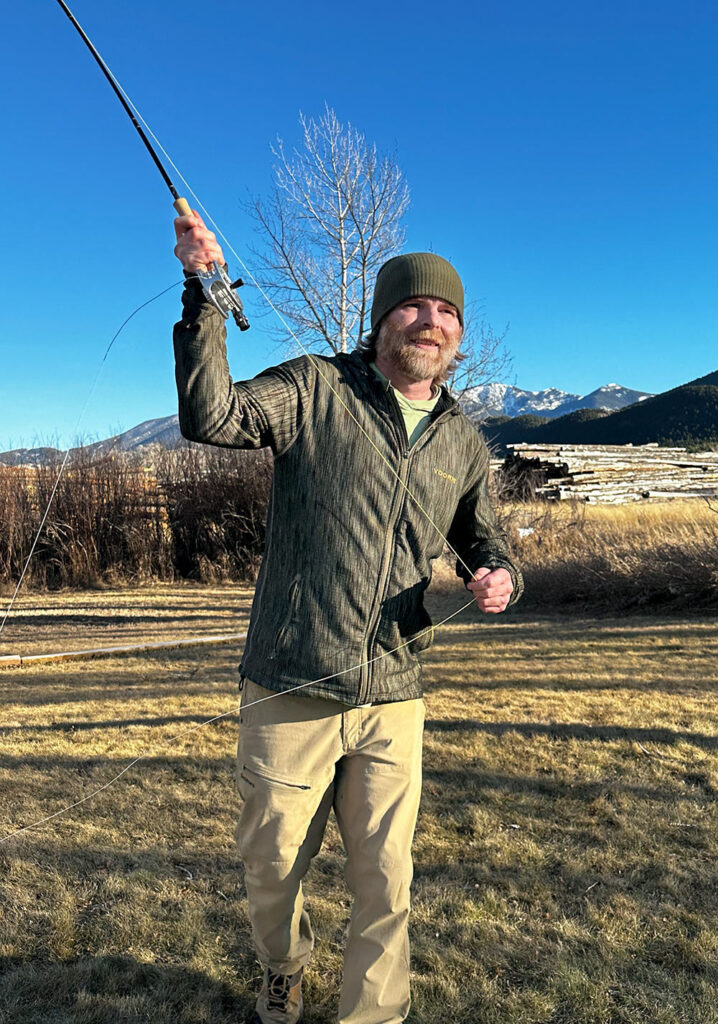
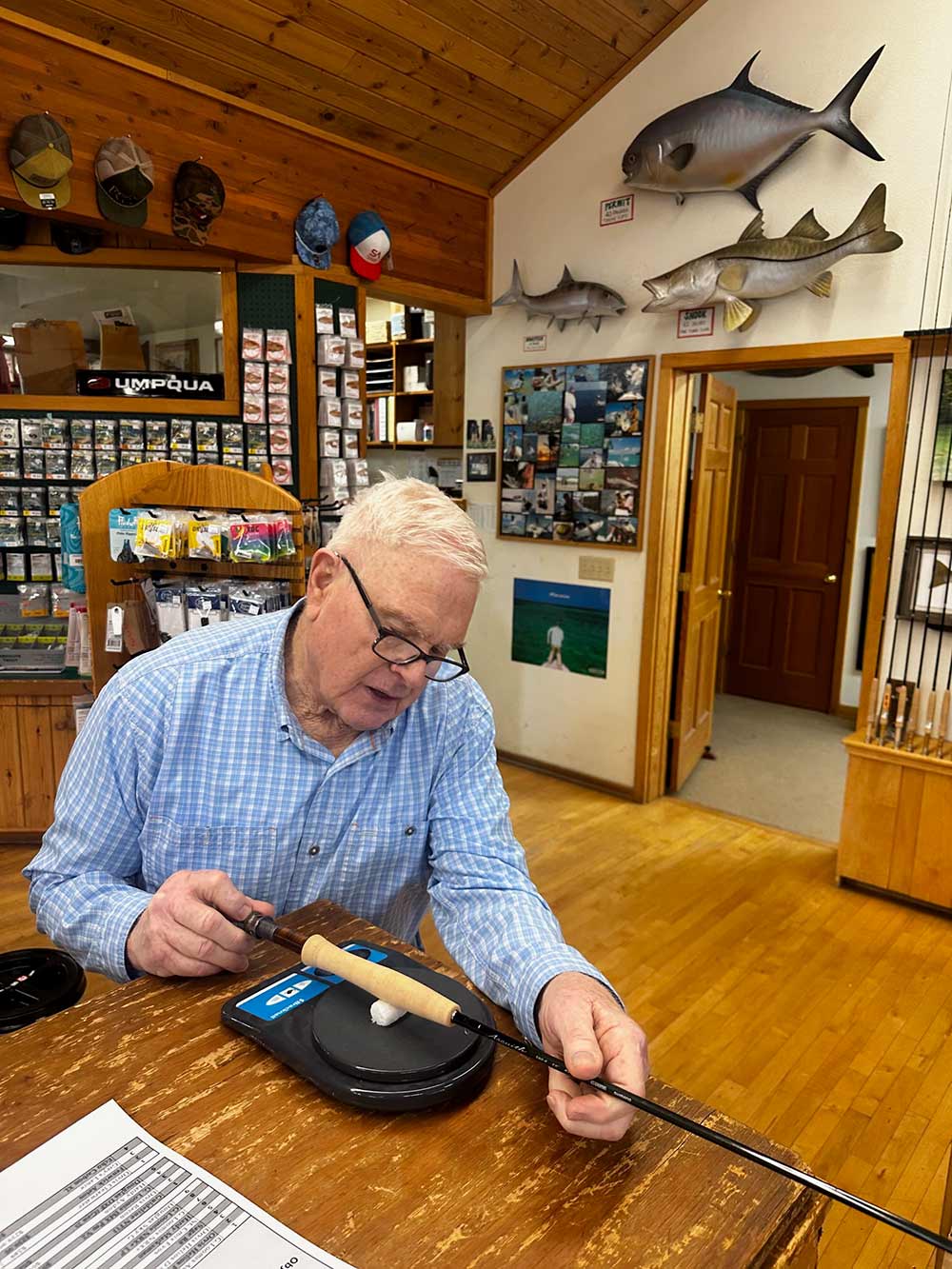
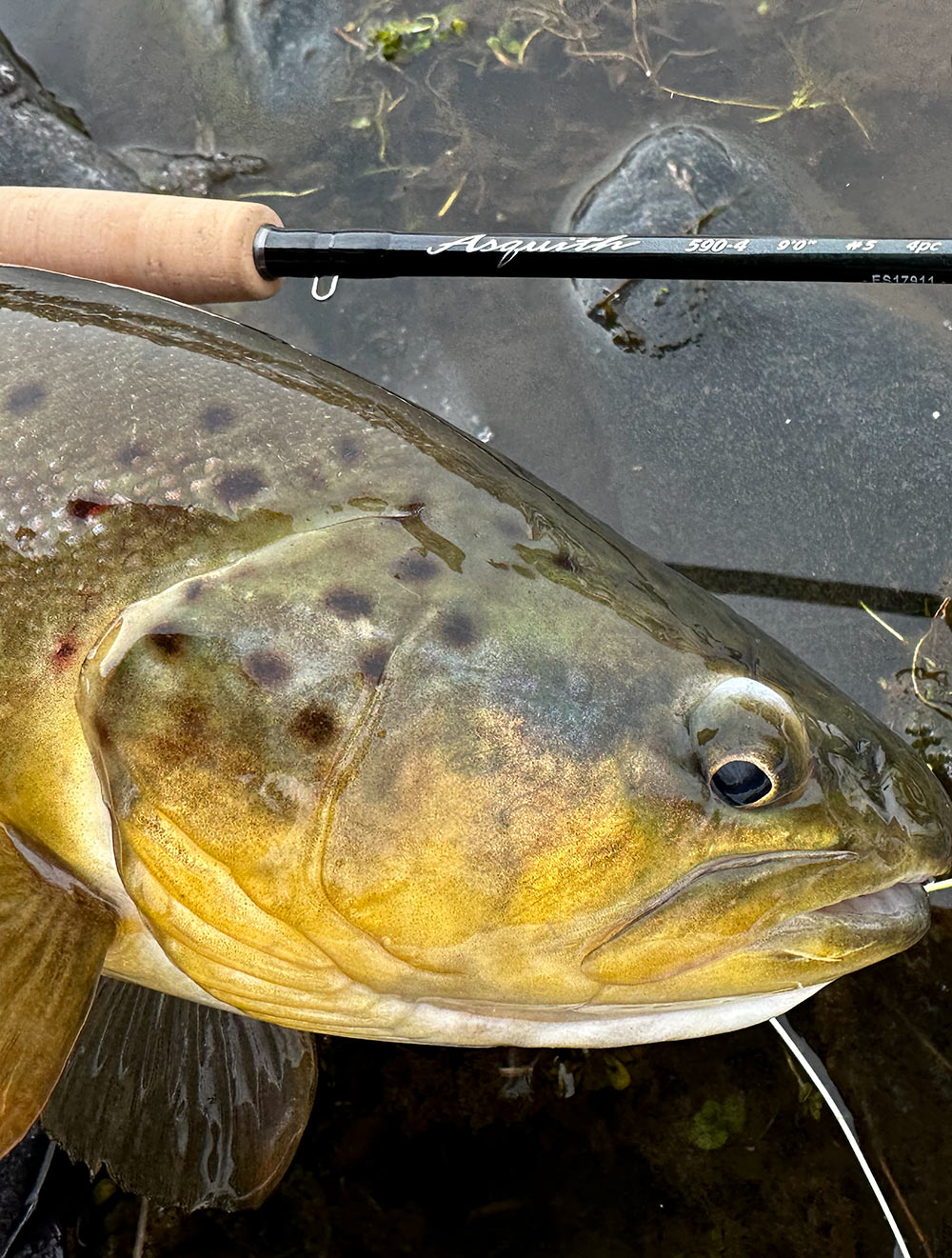

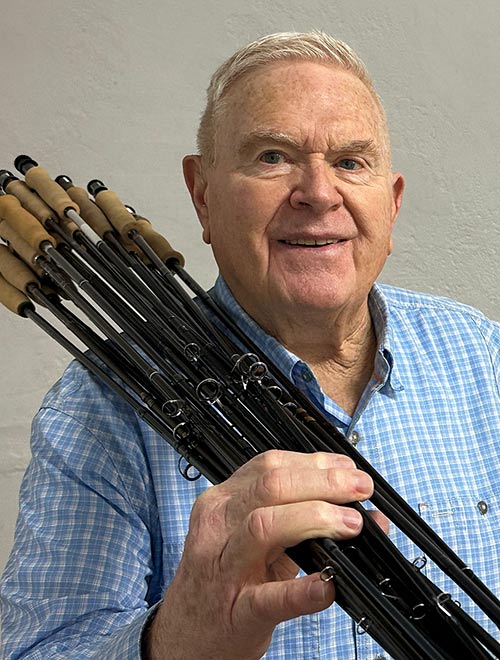
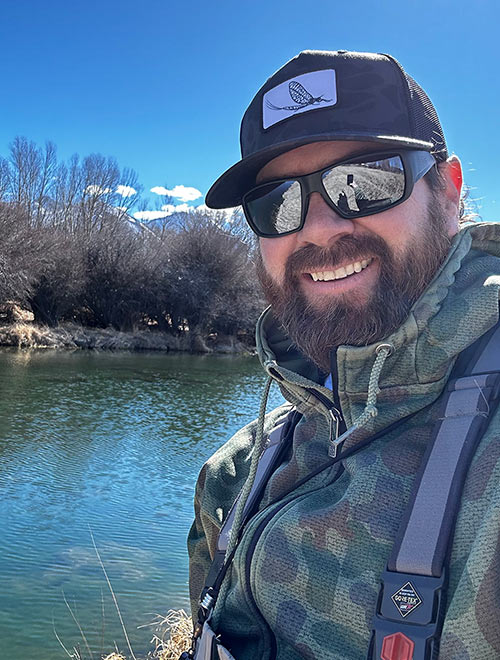
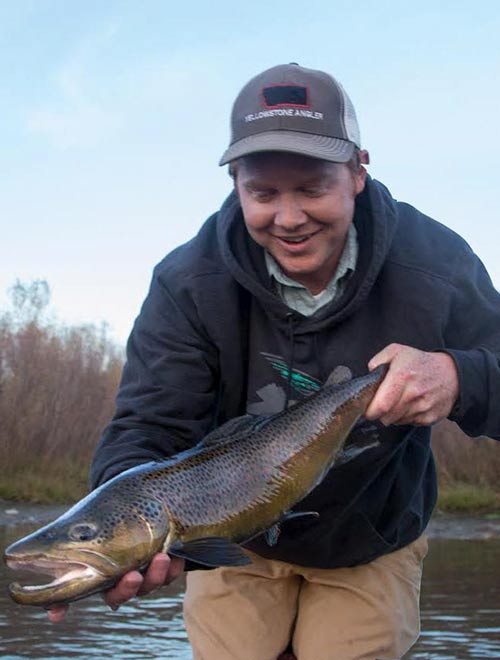


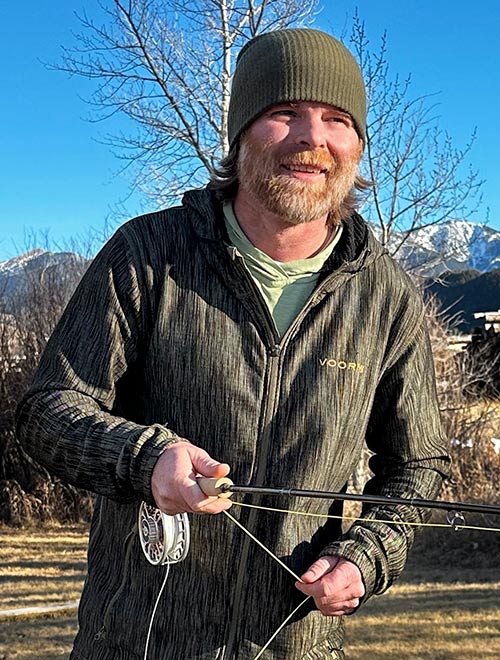
I’ve been in the fly-fishing business now for over fifty years, as a guide, fly shop manager and owner. With experience in both fresh and saltwater, many rod makers and manufacturers have consulted with me during their design process, including G. Loomis, Douglas, Sage, Scott, Winston, and Tom Morgan Rodsmiths.
My son James is also a dedicated fly fisherman and has developed into a great caster and a person who I can trust in judging a rod’s performance. He has been a very important and integral part of our Shootouts and tackle comparisons over the years. He is also responsible for many of the great photographs you’ll find in our Shootouts.
Logan Brown, our guide bookings manager has lived in Montana for nearly 20 years now. I have fished for golden dorado as well as for big rainbows at Jurassic Lake with him. He has proven himself time and time again to be a good angler and caster, even in the toughest conditions imaginable.
Justin Todd was born in Billings and grew up fishing the Yellowstone and other blue ribbon streams in southwestern Montana. Later in life, as a park builder for Mammoth Mountain, Justin spent all of his days off hiking and fishing the Sierras. He is passionate about fishing and the amount of time he spends on the water adequately supports his knowledge of what a great fly rod should do.
Ken Phillips has been fly-fishing for nearly 45 years. Ken was the youngest member in his Michigan angling club, and soaked up all things fishing like a sponge from his mentors. While he has a tremendous collection of bamboo rods, he is a great caster and appreciates all kinds of fly rods – from fiberglass-slow to ultra-fast and everything in between.
Joe Sherman was born and raised in the Adirondack mountains of upstate New York where he learned to fly-fish at an early age. After serving in the US Navy he earned a law degree and spent more than 20 years in corporate America before trading the office in Atlanta for Big Sky country. Joe is a great caster as well as a great guide in Yellowstone National Park.
Fly rods are getting better and better every year. Often only subtle differences separate one rod from another. Casting and rating the performance of the rods at different distances is the real meat of our Shootouts, and also the reason we have separate charts for each tester’s Performance Only scores. The overall results chart shows you the various categories at which we scored rods. You can evaluate for yourself which categories are more important, (such as price, reel seat functionality, warranty, performance at 25’, etc.) in your choice of the best rod for you.
The only good way to pin down these subtle differences is to have at least three or four rods in front of you with the lines stripped out, stretched and with the leaders straightened so that you can pick up one rod, make a few casts at a specific distance, then immediately pick up another rod and do the same. Only then do some of the subtle differences become apparent. Then move on to the next distance and repeat the process.
Once we score all the rods at the different casting distances, we then combine them with the total points in the other categories to determine the final rankings shown in our Final Results chart.
Remember, what you read here are only our opinions. We are trying to call it as we see it in an unbiased manner. Along the way, we expect we will ruffle some feathers.
In the past, we have received criticism for not evaluating the rods in a fishing setting. The main reason for not fishing them is we feel that it is much more difficult to accurately compare rods side-by-side fishing than casting them on the lawn. As mentioned above, on the lawn we can pick up a rod and in an instant pick up another rod to compare it at the same distance. This immediate rotation of multiple rods is virtually impossible on the stream, (unlike like golf – there are no caddies here).
It takes a while to get the feel for a rod while fishing it. And naturally during this time you adjust to the rod. Like a puzzle, you figure out what works well and what micro muscle movements allow the rod to perform best, whether it is a cast, mend, or strike. All the adjustments are natural to expert anglers, and hence a good angler can make any of these rods work.
Compare casting rods on the lawn with testing a flight of 4 beers. You taste one beer, and then immediately taste another. After quickly trying all 4 beers you will likely eliminate one. Then you can focus on the other three to find the more subtle differences, hopefully coming up with a beer to call your favorite. Fishing the rods is more like going on a pub crawl and ordering one beer at a time. In most cases your taste buds will adjust to that beer and you’ll likely enjoy it. In the same way if you go fish with a rod for an hour you are probably going to like it, or at least adapt to its characteristics.
The other big reason for not testing on the water was that we didn’t want to damage the rods, as we were returning them to each manufacturer. This year we kept the rods, (which most will be donated to the various charities we work with). This allowed us to take the rods to the stream without fear of damaging them, whether a tungsten bead head hits the tip, or the rods get scratched when laying them down on the rocks.
All of our testers fished some or all of the rods and their fishing observations appear in their individual notes. By far, the most thorough and comprehensive impressions appear in James’ notes. To see these, click on his blue drop down bar under each rod, or click here.
As you may have read by now, our #1 rated rod, the Sky G sells for $845.00. More expensive rods like the G. Loomis Asquith retail for $1,235 ($390 more) while the Orvis Helios rods sell for $1,098 ($253 more). Our favorite mid-priced rod, the Guideline NT11 sells for $599.99, about $75 less than the Scott Session. As you will see, some of the best Mid-Priced rods outscored a few of the Elite rods in our Final Results.
Craftsmanship is undeniably better on the most expensive rods, and with a few exceptions they generally perform better than the less expensive rods. But will they make you a better angler? Our answer is almost always YES! The more expensive, top performing rods have the ability to throw tighter loops, are dampened better so they track better, to give you more accuracy and better presentations at all distances.
Expensive rods do have that wow factor that will impress your fishing buddies. Are you comfortable showing up with a $200 rod when everyone else has one of those hotshot $750 to $1000 rods in their hands? It’s also nice to admire your rod and appreciate the craftsmanship as well as its performance. But is that high priced rod really worth $300-$700 more, by whatever standard you apply? Only you can make that decision.
With the inexpensive warranties that most manufacturers now offer, you are going to use your new rod for many years, which makes it easier to justify buying one of the more expensive rods.
Our advice has always been to pick the best performing rod, for your fishing application, even if it is a little more expensive than what you had planned. You’ll never regret spending those extra bucks once you get the rod in your hands and see how well it performs.
As in our past Shootouts, it is important to try to eliminate any variables that will have an effect on the scores at different distances. For obvious reasons, the line will be the biggest variable (which you can read about below) but we did our due diligence to try to keep everything else the same.
We tried to keep the rest of the variables apples to apples by using the exact same reel, the same amount of backing (and hence weight of backing), and the same type and length of leader. We kept the same tippet length, as well as the same size small yarn indicator we used on the end for visibility. Larger yarn indicators with more wind resistance can substantially affect the scoring.
Before casting, we stretched the fly lines and leaders, leaving the extra fly line (running line) piled in front of each casting station.
By setting all the rods up in an identical manner, it was easy to take a few casts with one rod at a particular distance, at say 45 feet, then pick up another rod and cast the same distance. Having multiple outfits set up allows us to do this easily. Over the years we have discovered that it is more difficult to judge the subtle casting characteristics among rods if you need to take the time to strip all the line off one rod and then re-load the next rod. Also, by having 10-12 rods set up 3 or 4 testers can cast simultaneously.
Aside from the line, one of the biggest variables is the wind, especially here in Livingston! As anglers, we are often dealing with the wind. If we could control the wind so all the rods tested were evaluated in identical wind conditions we would do so. Unfortunately, Mother Nature rarely cooperates in that respect. Winds are almost always gusty, with wind speed being unpredictable and varied. We have found that trying to judge accuracy and a rod’s ability to form tight loops (or track well) is nearly impossible if you have winds more than 5-10 mph.
We have found that the only fair way to compare rod performance (specifically accuracy), is in the absence of wind. So for our first three days of casting and comparing we did this indoors at the Livingston Civic Center. Later, on nice days with little wind, we did the rest of our casting outside on our lawn here at the shop.
As in our last 5-weight Shootout, we decided to again use the Galvan Torque (T-5), a wonderful light reel with a very smooth and highly adjustable drag. This reel is the one that won our 2016 5/6 Reel Shootout. I love the large drag knob on the backside of the reel that is easy to grip and adjust. These Galvan reels also have a wider range of drag adjustment than other reels, making it easy to fine-tune the drag adjustment, which is important when you are using light tippets like 6X and 7X. Much of the time when you are fishing dry flies, and hooking smaller trout, you can just strip the fish in, but if you are fishing nymphs or streamers with heavier tippet like 3x-4x, you’ll want to play the larger fish on the reel, and this requires a smooth drag that you can adjust easily.
Removing the spool is easy – just a simple click of the button on the handle side. I also like the handle design – it tapers outward, allowing you to quickly get and maintain a solid grip. Galvan uses a counterbalance so that the reel runs perfectly smoothly when a big fish is smoking away from you. The Galvan reels are essentially maintenance free, with Rulon bushings that require no maintenance or lubrication to keep them working properly. We loaded each of the reels with 100 yards of Cortland 20lb. Micron backing.
In past Shootouts, we strived to keep everything “apples to apples” which included using the same line on all of the rods. During preliminary casting rounds we tried several lines but settled on the Scientific Anglers Amplitude Textured MPX WF-5-F as our favored line, since it performed best on most of the rods. The concern with this method was that we weren’t necessarily finding which one of the fly rods was the best, but we were determining which one of these rods cast the Amplitude Textured MPX the best. Maybe, on some of these rods, a different line might improve its performance.
This year we decided to cast each rod with each manufacturer’s recommended line. While our apples to apples theory gets thrown out the window, we felt this was the most fair to each rod (and manufacturer). We arrived at this decision after listening to constructive criticism about the Shootout, mostly from on-line forums or in social media comments, and from our independent editorial consultant.
By giving each manufacturer the chance to tell us which line they thought best showcased their rod, in theory each rod is “tuned up” to the best of its ability. In most cases, this was the line that the rod designer used during the process of designing and testing the rod. We then cast, (and compared) each rod head-to-head, each rod now performing at the theoretical pinnacle with the line that works best on it. Most of the time we agreed with each manufacturer’s line choice. Even if we thought a rod felt better with a different line, we still stuck with the manufacturer’s recommendation for all testing purposes.
Below you can read about each line, their differences, and which rods used each line. You can also refer to our Objective Observations chart to see each manufacturer’s line recommendation.
A quick sidenote gripe with all the line manufacturers before we jump into each line. We used to receive lines on plastic spools. Scientific Anglers was the first to eliminate these, supplying a cardboard spool instead. The idea was that this would reduce plastic waste, and there would be less plastic at the landfill. It didn’t take Rio long to follow suit.
The problem with the cardboard spools is that the lines often tangle when we are spinning them on a reel. Every blue moon you get lucky and they work nearly as well as the older plastic spools, but it rarely happens. The other issue with the cardboard disposable spools is they are not as good for storing used lines as the original plastic spools. Line companies say they are worried these plastic spools will end up in the landfill, but now that they are no longer used these are like GOLD and NEVER get thrown away!
We wish they would go back to the plastic spools or make a better cardboard spool that doesn’t cause the line to tangle when you spin it on a reel and that can be reused to store used lines.

In the meantime, our work-around to storing lines has been to spin lines on to one of SA’s Regulator Spool ($29.95). You can spin the lines on with the Regulator’s arbor in the large position, and once you are done you can reduce the arbor so the line comes off. When we sell new lines we save the pipe cleaners and coated wire that keeps the line coils together. If the line ID is relatively new it can still be read, but over time the markings can come off or become hard to read, so on these we add a hang tag so you can ID quickly in your pile of lines at home. To see a video of how it works click here.
Douglas Sky G, G. Loomis NRX+, Orvis Helios D, Douglas DXF, G. Loomis IMX PROV2, Orvis Recon, Orvis Clearwater.
We have been Scientific Anglers line fans for years, and their Amplitude MPX line is a perfect choice for many medium to fast 5-weight rods. This line is a half-size heavier than a normal trout taper. The Amplitude MPX in WF-5-F has a total head length of 36 feet with a 6.5-foot front taper that allows for a quick turnover in the wind.
The MPX is especially good with larger, more wind resistant flies like hoppers and stonefly dries. The Amplitude Textured MPX utilizes tiny “golf ball dimple” laser cut-outs, which help reduce friction in the guides and also with surface tension on the water. These cut-outs create the ultimate in floatation. With SA’s AST Plus slickness additive these Amplitude MPX lines shoot like crazy!
The Amplitude MPX is a ninety-foot three colored line – the 8-foot tip is buckskin, followed with a 35-foot belly that is moss green, and then the rest of the running line is optic green. Having the difference in colors between the head and running line allows you to judge how much line you have out of the rod in the air, and when casting longer distances using a double haul.
G. Loomis Asquith, Sage R8
The Elite Rio Gold is a fan favorite, and certainly one of our best-selling Rio lines. In the WF-5-F size, it is heavier than a true to weight 5-weight, somewhere between a quarter of a line size heavy and a half line size heavy. If you feel like an Elite Rio Gold is a little light on your current rod, try the Elite Rio Perception, which is a true half a line size heavy.
One thing I like about the Rio Gold while casting the Asquith and R8 at 45 and 60 feet was the longer belly and rear taper gave me extra stability, making it easier to dial in accuracy at distance. I feel like the Elite Rio Perception would be better at 25 feet, fishing two nymphs under a strike indicator, or throwing a streamer.
Rio’s Elite lines all employ low-stretch Connect-Core Plus which give the angler enhanced detection of takes, faster hook sets, and greater control. Built with Rio’s SlickCast, these lines shoot and float very well.
The Elite Rio Gold is a tri-tone colored line, which helps to judge distance. The running line is light gray, followed by a yellow rear taper and mid, and an avocado green upper mid/tip. Two factory welded loops are included along with a line ID. Both the fly line box and spool are made out of recyclable materials.
Fenwick Aetos, Grey’s Lance
The Elite Rio Perception is Rio’s top-quality line that is half a line size heavy, similar to the SA MXP or SA Infinity. The Perception has become my favorite Rio all-purpose line for trout fishing. The Gold, (roughly a quarter of a line size heavy) is often too light to match today’s fast action rods while the Grand (a full line size heavy) is too much.
On the Fenwick Aetos and Grey’s Lance, the Perception loaded the rods in close at 25 feet, (especially the Lance), felt perfect at 35-45 feet, and threw stable loops at 60 feet, (especially on the Aetos). In fishing these rods, we found the Elite Rio Perception’s 8’ front taper worked great for turning over bulky dries like chubbies and hoppers, and also performed well throwing two nymphs under an indicator – even in the Livingston wind. Streamers? No problem.
The Elite Rio Perception utilizes Rio’s low-stretch Connect-Core Plus which gives the angler enhanced detection of takes, faster hook sets, and greater control. Factory welded loops and a line ID are included. A tricolored line is featured to help visually measure distance – the running line is a light gray, followed by a dark green back taper to the middle, and finally a brighter chartreuse green from the middle of the body to the tip. Both the fly line box and spool are made of recyclable materials.
Hardy Marksman, Hardy Aydon
We were very impressed with the performance of Royal Wulff Product’s new Triangle Taper Signature Plus lines. Royal Wulff essentially “beefed” their classic Triangle Taper up a little to better match the faster action rods we are seeing today, while still keeping the essence of what makes the Triangle Taper Classic so smooth and fun to cast.
Aside from adding more grain weight, Royal Wulff also shortened the front taper from 36 feet to 30 feet. This is still a very long front taper compared to all the other lines in our Shootout, (with the exception of the even longer front taper of Guideline’s Presentation+ at 58 feet).
We really enjoyed this line on both the Hardy Marksman and Aydon as we were able to make accurate casts and enjoyed stable loops even at 25 and 60 foot limits. The only downside to the line is that if you are primarily casting at 25 feet, other lines like the MPX will give you more feedback since more grain weight is out of the tip of the rod. We would likely have scored the Marksman a 20 at 25’ with the MPX line on it. Also, if you are looking to throw double nymph rigs under an indicator, or heavier leadeye streamers often, then the Triangle Taper will challenge all but expert casters. For DFO (dry fly only) guys, this is your line!
For anglers who want the ultimate performance we suggest the Triangle Taper Signature Plus Textured line ($129.95), which is the same line as the Signature Plus but with a textured coating. Like the SA textured lines, these have less friction when sliding through your guides, float better, and pick up more line from the water. Royal Wulff also gives you three colors instead of two. The only downside that we see with these is the “zipping” sound they make while casting.
The Triangle Taper Signature Plus comes with two factory welded loops and a laser ID for line identification. The fly line box and spool are eco-friendly and made of recyclable materials.
G. Loomis NRX+ LP
The Elite Technical Trout is Rio’s high-end, true to weight line. It worked well on the NRX+LP as an all-around line, forming stable loops with delicate presentations. Of all the true to weight lines, we feel the Elite Technical Trout fared the best when pushed to the limits while fishing two nymphs under an indicator or for throwing streamers.
A great all-around line, especially if you are the type of angler who wants to fish dries 75% of the time, but are not afraid to get “down and dirty” if the fish are only feeding under the surface.
Rio’s Elite lines all use low-stretch ConnectCore Plus which gives the angler enhanced detection of takes, faster hook sets, and greater control. Built with Rio’s SlickCast helps these lines shoot and float well.
Rio’s Elite Technical Trout lines come with factory welded loops and a line ID. They feature a tricolored measuring system for increased accuracy and distance control – the running line is gray, followed by an orange sherbet rear taper and a light blue body / front taper. Both the fly line box and spool are made out from recyclable materials.
Guideline NT11
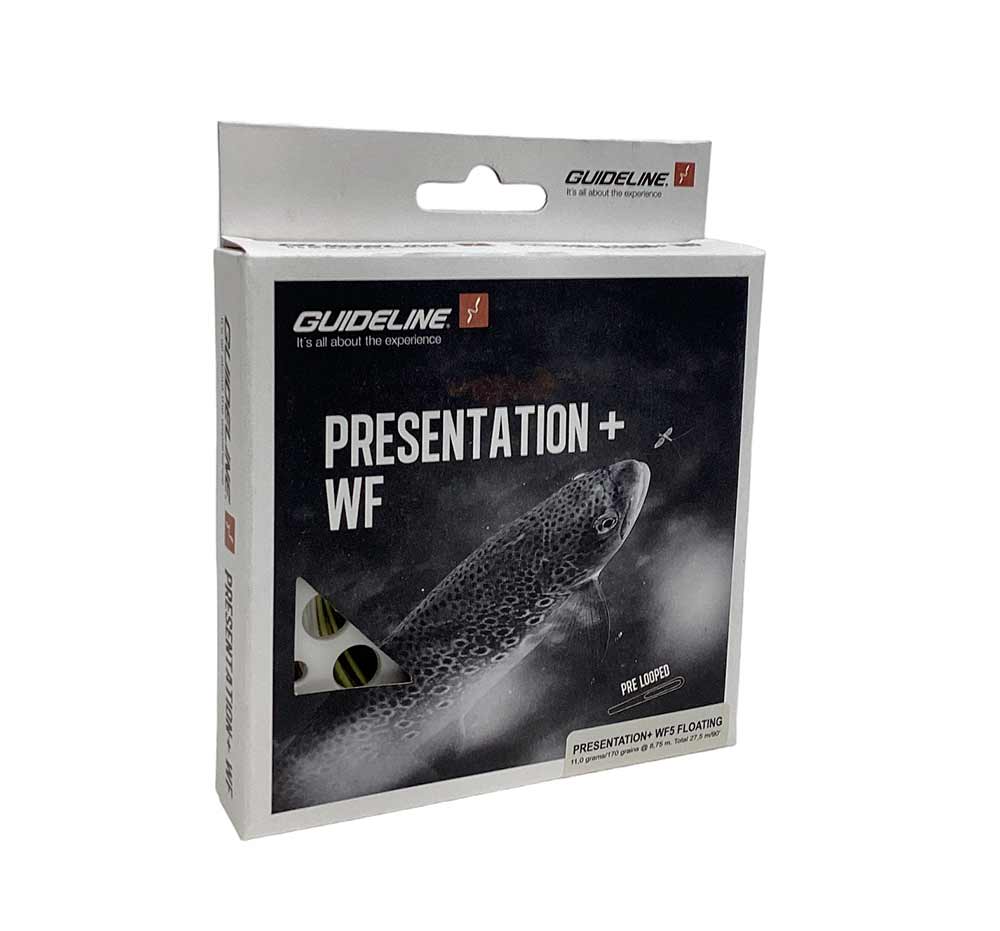
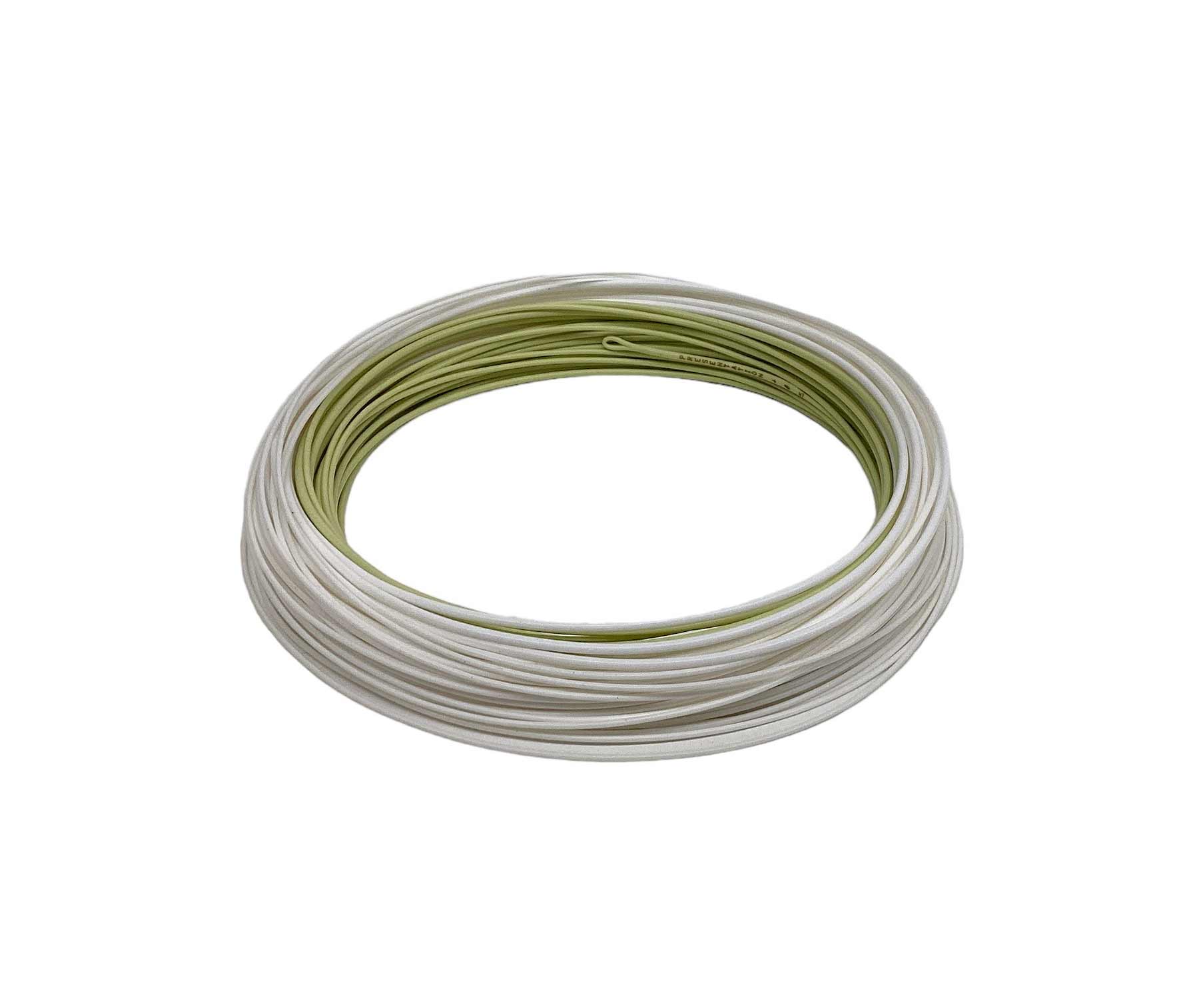

Guideline has improved their original Presentation line, (one of their best-selling lines to hit the market since 2002), by increasing the thickness of the handling line and running line. This increase in grain weight better matches today’s fast action rods, promoting better turnover as well as a more stable loop in the air. Like the Triangle Taper Signature Plus, the Presentation+ has a very long front taper (58 feet!), which helps promote a smooth casting stroke and eliminates the “hinge” feeling that is common on shorter front taper lines.
Guideline seems to have perfectly improved the line by producing a line with enough punch and velocity to handle most winds, nymphs, and small streamers while excelling primarily at smooth delicate, dry fly presentations. Since the rear taper is thicker and longer, it also pairs well for single hand spey casts or water-loaded casts. We did struggle with the Presentation+ when casting a streamer at 60 feet however, and found it doesn’t handle a burly two-nymph freestone rig under a bobber as well as other lines. Still, we thought it was a great all-around line and the perfect match for the NT11, making the rod feel light, powerful, and lively.
The Presentation+ is built on a braided monofilament core. Guideline includes two factory welded loops and a line identification laser ID. The Presentation+ is phthalates free, a toxic agent that is known for softening PVC lines. Both the fly line box and spool are made of eco-friendly recycled materials.
Orvis Helios F
In case you were unaware, Orvis owns Scientific Anglers. In May of 2013, Orvis acquired Scientific Anglers (along with Ross Reels, which Orvis has since sold). The point is, Orvis has access to some of the best line manufacturing technology in the world.
The Orvis Pro Trout is a true to size line, meaning it is a 5-weight line, not an oversized “5.5-weight” like the SA MPX or Infinity. It has a complex front taper, which is broken down into three sections instead of one: From the tip of the line, the first front taper is about 4 feet, with very little mass gain. The second front taper is also 4 feet, where the line begins to build in size. The third front taper is 18 feet, and gets much thicker until it gradually hits the belly of the line. This multi front taper seems to work well as an all-around line, especially for medium fast rods like the Orvis Helios F. The 50-foot head with its relatively long rear taper was also good for mending as well as making water-borne, single hand spey casts.
The Orvis Pro Trout lines have AST+ coatings as well as golf ball dimples cut out of it to reduce friction, (the same as its SA amplitude textured line siblings). The Orvis Trout Pro comes with two welded loops as well as a line ID. As with Amplitude Textured lines, the Trout Pro comes in a tri-tone colorway, however, this one has a peach-colored running line, olive belly, and sage tip.
Scott Session
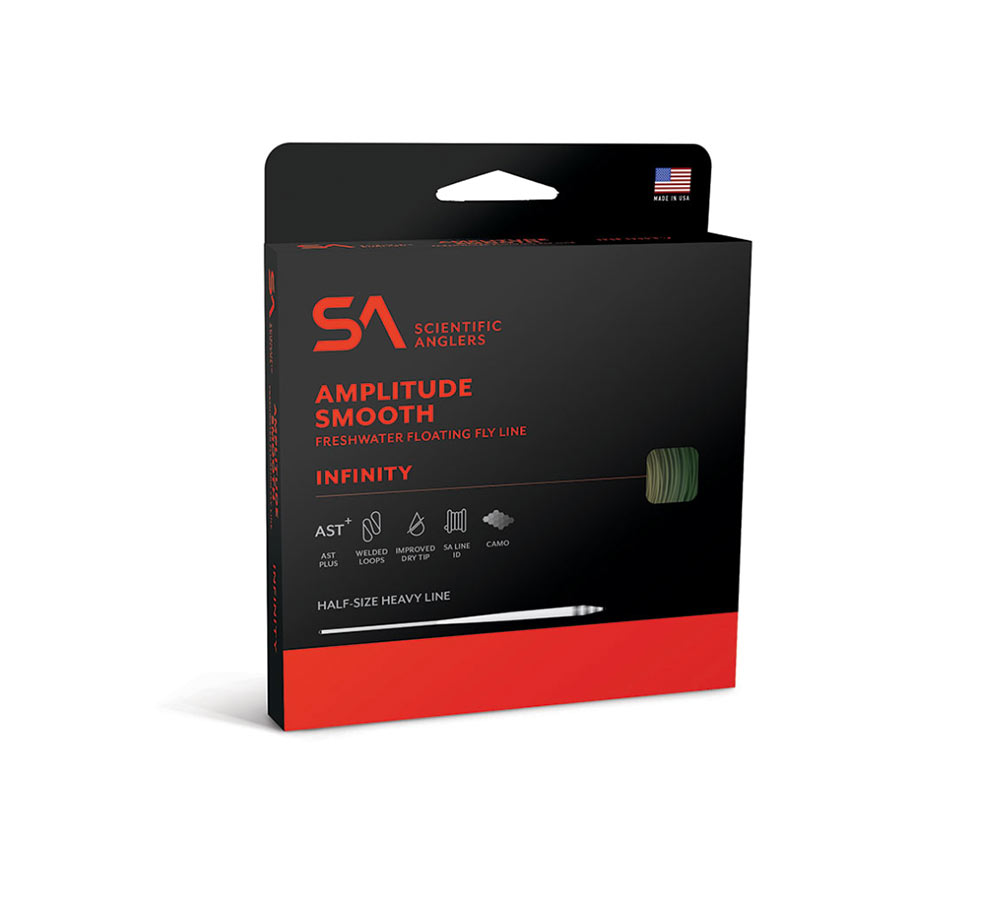


Scientific Anglers’ Infinity Smooth line, like the MPX is a half a line size heavy. The difference is where extra grain weight is distributed on the line. With the MPX, those grains are pushed further towards the tip, giving the MPX the “hero” line experience and performance of a modified shooting head. With the Infinity those grains are distributed more evenly through the front taper as well as the belly of the line, improving the delicate presentation of the line while still matching the flex of today’s fast action rods.
The result is an all-around line that has the power to bomb out streamers and turn over double nymph rigs as well as the improved presentation when fishing dries. Since the line has a longer belly and rear taper it produces stable loops at distance and also is better at mending or water-born single hand spey casts.
Scott chose the Infinity Amplitude Smooth version. Many of the guys at the shop prefer the Amplitude Smooth coatings as they don’t make any noise zipping in and out of the guides while casting. But at my age, I can’t hear any of this! (and prefer the better performing Amplitude Textured lines, ha ha).
Personally, I’m still sticking with my Scientific Anglers’ Amplitude Textured MPX in the WF-5-F (and WF-6-F) size. Depending on the rod, I do prefer the Scientific Anglers Infinity Textured WF-4-F. For three weights I prefer the Scientific Anglers Trout Amplitude Textured WF-3-F.
For whatever reason I feel all of these Amplitude Textured lines outlast all the other brands of lines I have used.
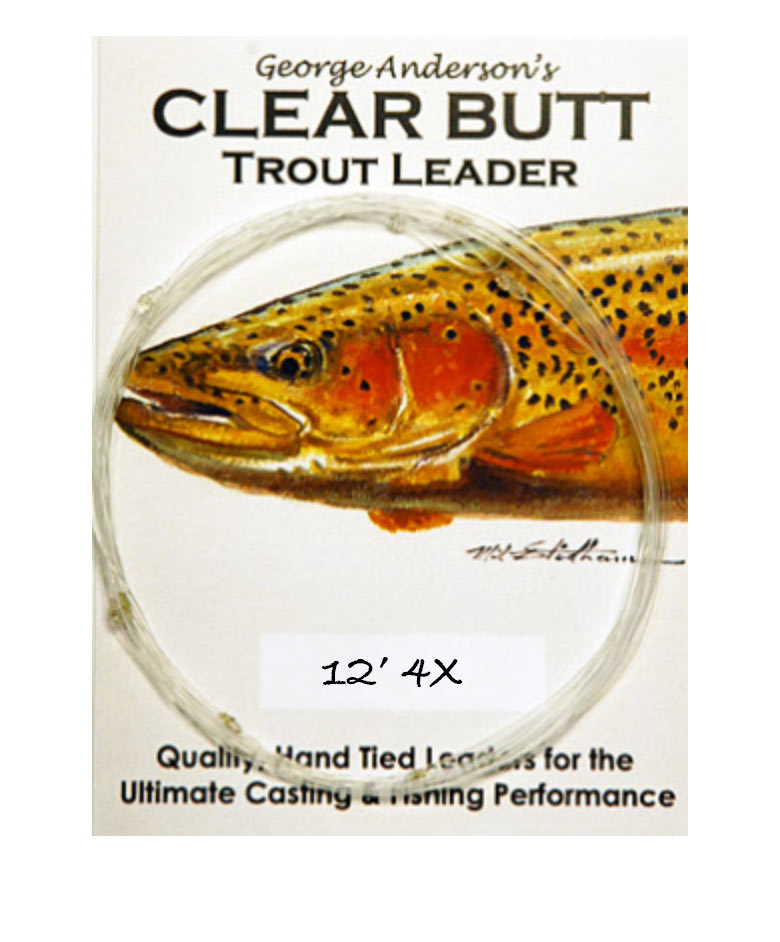
Leaders are extremely important in obtaining accuracy, particularly ones that will turn over well at short distances with very little fly line in the air, especially at 25 feet. Just about any rod will turn over a 9-foot leader easily. But having to turn over a 12-foot leader forces a rod to perform at a higher level.
As in the past, we prefer to set up all the test lines with our own Yellowstone Angler hand-tied leaders. For this 5-weight Shootout we used our Clear Butt 12 foot 4X leaders. These utilize clear Maxima butt and midsections with Rio nylon 4X tippets. Our hand-tied leaders turn over better than any of the 12 foot knotless leaders we’ve found and are also more accurate than chemically tapered leaders.
On my own 5-weight rods, I’m normally using a 12-foot leader, with tippets from 4x to 6x, fishing dry flies. A 12-foot leader keeps the fly line farther away from the fish, minimizing the number of fish you will spook while casting. If I’m fishing a more wind-resistant fly like a hopper pattern or stonefly, I’ll cut the leader down to 9 feet or less and end up with a 3X-4X tippet.
When I’m nymph fishing, I often switch to one of our Hot Butt Leaders that utilizes five feet of fluorescent red Amnesia for the butt section, followed with the same clear Maxima we use in our Clear Butt leaders. Since our Hot Butt leaders use the same basic formula as our Clear Butt leaders I often use the Hot Butt leaders, even for fishing dry flies. This makes it easy to switch back and forth if I’m fishing both dry flies and nymphs.
To make it easy to judge turnover and accuracy, in our testing, we tie on a small fluorescent yarn indicator at the end of the leader that approximates casting a medium size dry fly.
Deflection charts have become an integral part of our Shootouts. These charts help to visually represent the subtle differences among rod actions. The butt and mid-sections flex pretty much the same with slight differences in stiffness. Where the big difference comes in is how much the rods flex in the tip.
Instead of a chart with all the rods, we break this down into multiple charts for easier viewing. Aside from breaking these down to groups with just the Elite rods, Mid-Priced rods, and Inexpensive Rods, we have also included other variations, allowing you to compare rods of different prices.
In making these deflection charts, we first staple white butcher paper on to the wall. We place each rod into a homemade, wall mounted jig, that positions each rod at approximately a 45 degree angle. We then hang a 3.9 oz. lead from the tip of each rod to make the rod flex. We tape the tip and midsection down, and trace each rod’s profile with pencil, later retracing it with a colored sharpie.
Using these charts, you can examine each rod’s profile and see how stiff it is compared to other rods and how much the tip bends. The faster action rods (not stiffer action rods) have tips that bend more with stiffer butt and midsections, while the more medium action rods have slightly softer butt and midsections and a relatively stiffer tip.
We have found that faster action rods with softer tips give you better feel, improved accuracy, and more delicate presentations, especially at closer distances. In general, but not always, rods with stiffer tips typically use more material and are thus heavier in swing weight as well.
Sometimes we find two rods that deflect nearly identically, but the actions and feel are significantly different due to the swing weight of the rod.

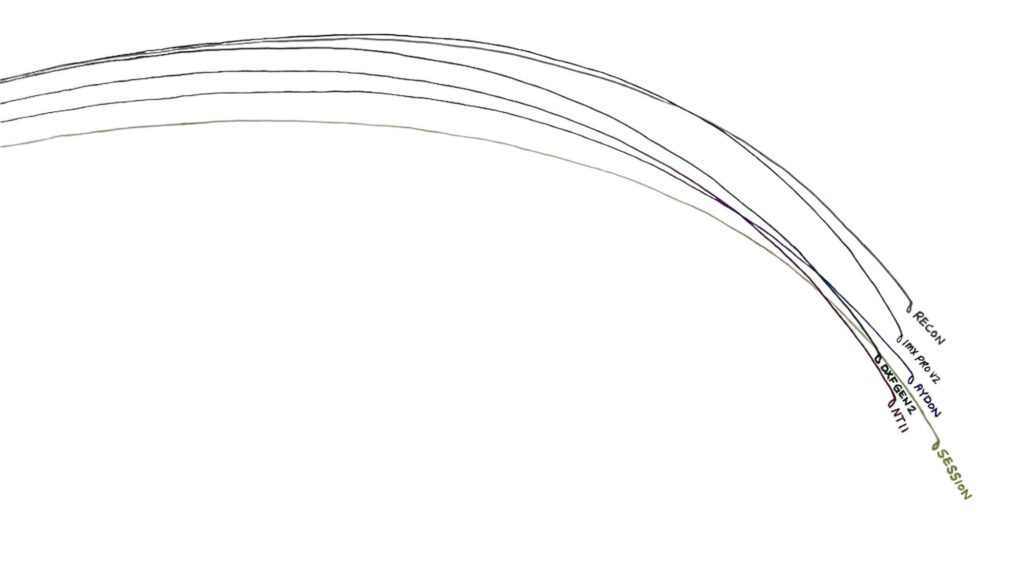
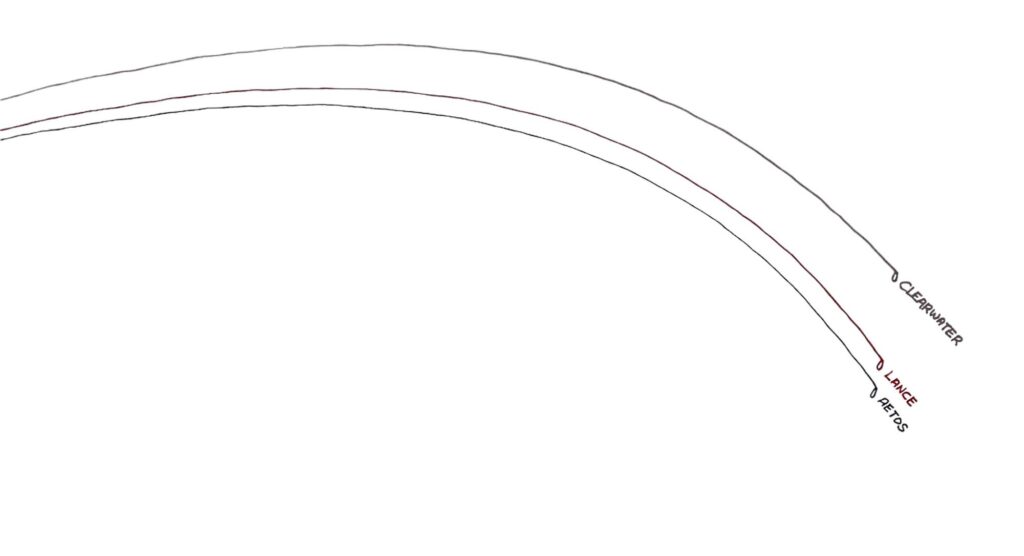
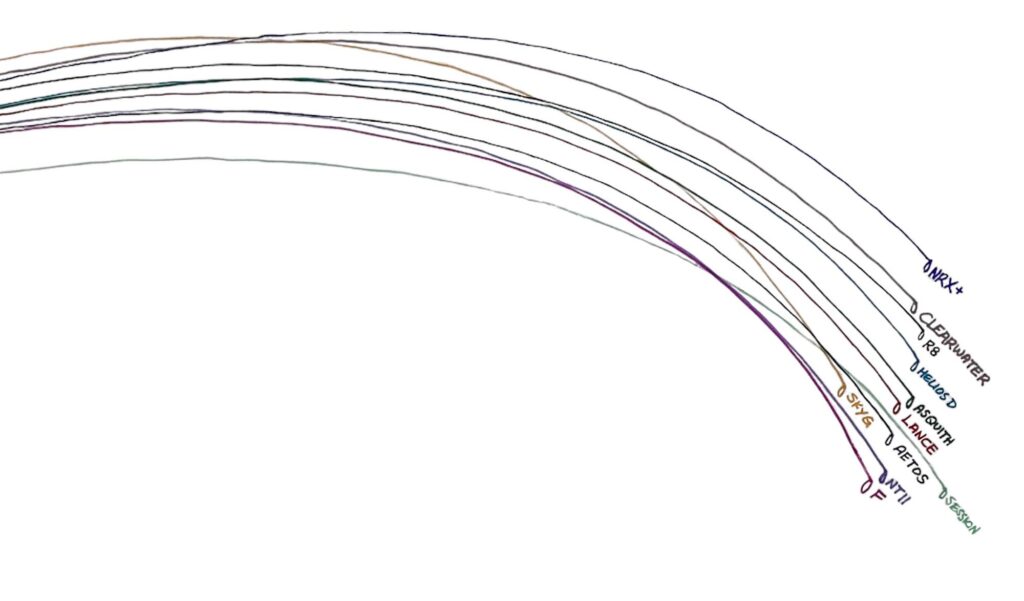
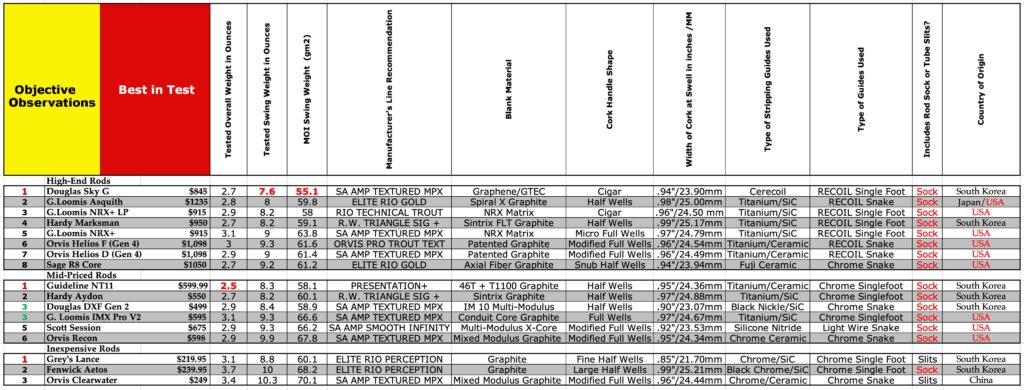
You may have already studied our Objective Observation chart above in the Results First section. Most of these categories are more or less self-explanatory. Others may need explanation. Here is our breakdown of each category:
In past Shootouts we have learned not to take the manufacturer’s word for it when it comes to weight. Too often have we found manufacturers falsely claiming lighter weights to capture a higher interest from consumers. Here you will find the figures from our Bracknell postage scale. *Note – we weigh all of the rods on the same day/hour to avoid possible differences caused by varying barometric pressure.
If you play golf, you are familiar with this term. The swing weight is the relationship of the club head weight to the shaft when you wiggle the club in your hands. The swing weight of a fly rod is the weight you feel out ahead of your hand, holding the rod horizontally. A little wiggle helps you feel this with fly rods as well. Rods with a light swing weight are delightful and effortless to cast. Rods with heavy swing weights feel clunky in your hand and are not going to be as pleasant to fish all day.
To see exactly how we measure swing weight with a postal scale you can view this short video from our 2019 4-weight shootout:
Note the swing weight section of the video is 1 minute long, (running from 2:43 – 3:43). You can watch the rest of the video to see how we deflect rods and our previous discussions, just remember this is from our 4-weight Shootout years ago and won’t show the current 5-weights tested here.
We found out about Sexy Loops’ Moment of Inertia Calculator from a European friend. This web site allows you to enter data into a database and then uses a complex mathematical formula to calculate swing weight. Anyone can use the calculator and you can do so with your own rod’s measurements. You’ll need to enter 4 things: 1. The weight of each section (in grams), 2. The length of each section (in meters), 3. The mass center of each section (in meters), and 4. The total length of the rod (in meters). To figure out #3, you’ll want to find the balance point for each section. We folded a business card in half, taped it to our countertop and then balanced each section, finding the mass center. There is a good diagram below the calculator showing which measurement will be your mass center. Last but not least, don’t forget step #4! You will enter the entire length of the rod (in meters) on the bottom row of the calculator. This is necessary because the overall length is used to calculate overlap in the ferrules and the distance from the rod end to the center of mass for each section.
In the past we found the MOI figures didn’t match exactly what we were feeling in our hand. This year we found the figures were, for some reason, closer, however, there were some slight discrepancies between the figures from our method and the MOI calculator figures. We didn’t have a great answer to why our swing weight figures didn’t align perfectly with MOI swing weight figures. We think some of this could be due to differences in the cork grip shapes, since we measured the fulcrum in the middle of the swell. Some rods utilize a swell that encourages your hand to grip it further towards the top. When you “choke up” on the grip, even if it is only a centimeter difference this can make the rod feel lighter in your hand.
At the end of the day we feel the MOI figures were worth including in our Objective Observations chart, especially for our readers with scientific or engineering interests.
Here you will find each manufacturer’s line recommendation for their rod. We have abbreviated some of these names to fit in the column better. Here are the non-abbreviated versions as well as their price:
Scientific Anglers Amplitude Textured MPX ($129.95)
Elite Rio Gold ($129.99)
Royal Wulff Triangle Taper Signature Plus ($89.95)
Elite Rio Technical Trout ($129.99)
Orvis Pro Trout Line – Textured ($129)
Guideline Presentation + ($84.99)
Scientific Anglers Amplitude Smooth Infinity ($99.95)
Elite Rio Perception ($129.99)
We asked each manufacturer “what type of material is your rod blank made from?” Without giving away any secrets, in this column you’ll find each manufacturer’s answer. All of the answers involved some kind of graphite, (technically carbon fiber) although each company has a specific marketing name for it. None of the manufacturers wished to reveal the modulus of graphite they used, nor which section they used it in. And we don’t blame them – this would be like trying to get Auntie Rae’s secret recipe for her salad dressing!
This one is simple, however certain manufacturers had different modifications and their own spin on certain grip shapes. If you have smaller hands, in general, we’ve noticed customers gravitating towards the cigar, micro full wells, or snub half wells grips. If you have larger hands, often a full wells or modified full wells will feel best. This is all personal preference, if it feels comfortable then go with it.
As the name implies, these grips have the general appearance of a cigar, perhaps a torpedo shaped Monte Cristo #2. While many cigar grips now have a slight flare at the bottom end, a true cigar grip won’t have any flare. The top end of all cigar grips is quite narrow, allowing anglers to cast with either their thumb on the grip, or instead place their index finger up on the blank. Classic cigar grips used to be standard especially on Eastern built, downlocking rods. Nowadays, builders still use cigar grips, however nearly all rod manufacturers are using uplock reel seats.
A half wells, also referred to as a “Western” grip or “reverse half-wells” refers to a grip that is relatively thin at the top, a swell in the middle, and a flare at the bottom of the grip (the reel seat side). We are seeing more and more of these on 5-weight rods particularly.
A full wells grip flares at both ends of the cork. These are often found on saltwater rods, (or powerful 6 weights) that are built for more power over feel. The idea with a full wells grip is that your thumb can nestle in the dip between the swell in the middle and the top flare, allowing you to apply more power for a more aggressive casting stroke.
A modified full wells, (also referred to as a micro full wells) is a miniature version of a full wells grip. The flares at both ends are not as large, although usually the top flare is even smaller than the bottom flare. These have become quite popular in 5-weight rods as they have proven to be great all-around grips for power and feel.
This is what Sage calls their version of a micro full wells. Sage’s snub half wells grips have become well known for comfort and feel and are certainly one of the best all-around shaped grips on the market today for a 5-weight fly rod.
In this column you’ll find the width of the cork at the widest part of the handle – excluding either of the swells at the top or bottom (that you would never grasp anyway). We found that nearly all of the handles were in a similar range here, however there were a few outliers. The smallest (thinnest grip) by far was on the Grey’s Lance at .85” or 21.70mm. Anglers with small hands will likely love this grip, anglers with normal to larger hands will probably dislike it. For anglers with meathooks, the Fenwick Aetos was the largest at .99” or 25.21mm, followed by the Hardy Marksman at .99” or 25.17mm, and the G. Loomis Asquith at .98” or 25 mm.
If you love your rod, but don’t love the grip width, you do have a couple of options. If the grip is too large in diameter for your hands, you can sand the cork down. If you are careful, you can start this process on a lathe. Perhaps you can sand off some cork or add 3M vetwrap tape to it if the grip is too narrow to begin with.
The stripping guide is the largest guide on the rod, the first one up from the butt section. Most saltwater rods have two stripping guides to help funnel their more powerful energy but all of the 5-weights we tested had only one stripping guide. These stripping guides all had some kind of ceramic insert, designed to reduce friction.
The most expensive of these are the Cerecoil stripping guides offered by REC components. These are the industry’s newest and most high-tech guide on the market, with a nickel titanium frame and a zirconia ceramic insert. The only downside to these rings is we have seen a very small sample “pop” out during the shipping process.
SiC stripping guides refer to silicon carbide, which are considered to be one of the best materials for stripping guides as they use a ceramic ring to reduce both friction and heat. Titanium refers to a tensile titanium frame.
We think a titanium/ceramic stripping guide is virtually the same as a titanium/SiC, just one made by a different manufacturer than Fuji. A chrome/ceramic stripping guide has a chrome frame and a ceramic insert. The chrome versions are the same color as the titanium but thicker (and heavier). A black SiC uses a black nickel frame.
A silicone nitride (SN) stripping guide is also similar to a SiC stripping guide. They also are made with low profile high tensile titanium frames but with a polished SN insert. Very similar to SiC, SN is a ceramic that is designed to reduce friction and heat, as well as add fracture resistance and strength.

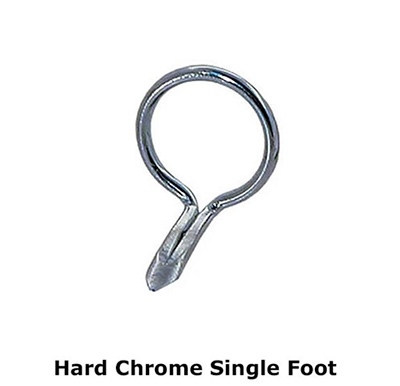
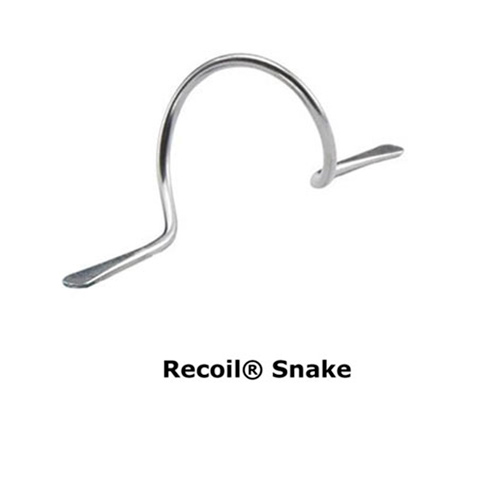

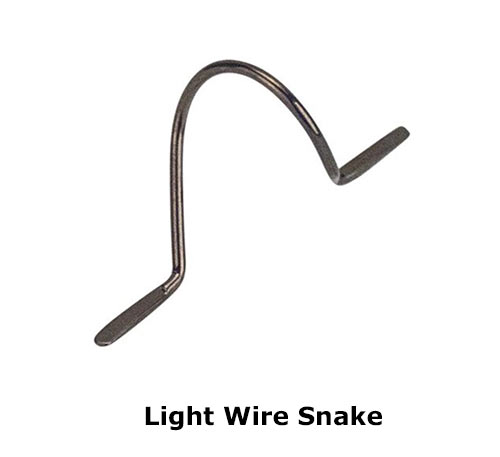
Here we look at the remaining guides located above the stripping guide(s). Snake guides have two “feet” which are both wrapped with thread and covered with epoxy. Snake guides have a spiral appearance and rarely ever pull out. Single foot guides only have one foot which is wrapped with thread and covered in epoxy. They cut weight because of less material, but mainly because of less epoxy. While rare, we have seen a few single foot guides “pull” out of their thread/epoxy dens.
Chrome guides, whether snake guides or single foot are made out of stainless steel with a chrome coating. These guides are significantly thicker and heavier than Recoil guides. Chrome guides are very durable. I can’t remember ever seeing one break in half, although they can get bent out of shape.
Recoil brand guides, whether snake guides or single-foot guides have a much thinner gauge wire and are flexible. They are made from a nickel titanium alloy which is extremely hard but flexible. If you push these guides down (or around) they will quickly “pop” back into their original position. The exception to this is in the middle of winter, on days close to 10 degrees F or less, we have noticed Recoil guides with stay in the same position you bend them in.
While all recoil guides are made from a nickel titanium alloy, natural titanium refers to the silver color guides whereas black pearl refers to the black color guides.
All of the rods in our 2024 5-Weight Shootout include hard rod tubes. Some of these hard cases are metal, others are made of PVC or plastic, covered with Cordura (a fabric weave).
Most high-end rods include some type of cloth bag. These cloth bags all have 4 separate sections to keep the individual rod sections from hitting each other. This keeps the rod from getting little transfers or scraping marks, either from other sections or from the rod tube itself.
This year both Sage and Orvis came up with new rod socks. The R8 rod sock now comes with a micro cord (black with reflective silver diamonds) and a pull tab that slides up, similar to a miniature bolo tie. We like this upgrade although their old strings were just as useful. Orvis on the other hand, includes a buckle with their new Helios rod socks. We think this is pretty cool and the logo on the sock looks sharp as well, complete with a length and weight designation.
We always prefer rods that offer rod socks as sometimes when going on a trip you want to bring 3 or 4 rods, (or even more). The best way to travel with this many rods is to take each rod out of their hard tube, and place all together, each in their respective rod socks into a carry-on tube or carrying case. Some of our favorite carrying cases hold both rods and reels including those by Fishpond, Sage, Simms, Orvis, Patagonia, and Nigiri.
One trick we like to do is to place one rod in the carrying case with the cork handle end on the left side, and your next rod the opposite way with the cork handle side on the right. This allows you to fit quite a few more rods if you are the kind of angler that brings 6-8 rods along instead of 3-4. You never know!
If a rod doesn’t include a rod sock, then their case will have interior slits that divide the inside of the rod tube. Like a rod sock, these slits allow each section to be separated so they can’t rub against each other. You will often find this solution with less expensive rods, especially in rod “kits” or “combos” where the rod, reel, and line are all sold together.
You will have to buy a separate rod sock if you wish to travel with one of these rods outside of its hard tube.
This one is self-explanatory – except for the Asquith. The Asquith blanks are rolled in Japan and shipped to Woodland, Washington where they are built and finished.

Simple – the lower the price, the higher the points awarded. Our three inexpensive contenders all got perfect 10’s, ranging from $219.95 – $249.00, (a $29.05 difference). The Asquith, now $1,235, gets the lowest score with a 6, while some of the best mid-priced rods like the NT11, Aydon, and the DXF, ranging from $549 – $599, (a $50.99 swing) were scored at 8.7 points.
In past Shootouts, we only had one category for craftsmanship, with 10 points available. We looked at many things to determine this – what types of guides are used? There are several types of stripping guides, but the best seem to be the titanium frame, zirconium or SiC (ceramic insert) style guides. We think the best guides above the stripping guide are the flexible nickel/titanium alloy single-foot and snake guides, which are much lighter (and more expensive) than the heavier, hard chrome versions. How well are the guides wrapped and how nice are the coatings? How about the shape of the cork and the quality? How about the reel seat quality and functionality?
This year we decided to break craftsmanship down into 6 separate categories, (Quality of Guides/Guide set up, Ergonomics of Cork Grip, Quality of Cork Grip, Reel Seat Functionality, Reel Seat Luxury, and Thread Wrap and Epoxy Finish).
Originally, we had these at 10 points available in each category, but we felt allotting 60 points to craftsmanship was too much, so we opted for 5 points available. But to our surprise, when we did preliminary calculations, this didn’t change the finishing order anyway, so we just stuck with 10 points available. The main idea is a least you can see how we scored craftsmanship individually.
Here we looked at two things: 1. What is the quality of the guides utilized? and 2. Do we like the style of guide set up?
The first part is simple. The best guide components happen to be the most expensive. Some manufacturers are willing to pay top dollar for the best parts, others appear to be saving money and padding their bottom line. For a large manufacturer this adds up quickly – if you can save $8.50 per rod on the cost of guides, multiplied by 10,000 rods a year that saves $85,000.00. Not exactly chump change!
As for the second half, we prefer lighter guide setups rather than heavier ones. This gives Recoil ® brand guides the edge since they are thinner and lighter than the hard chrome guides. Single-foot guides are lighter than snake guides. Not only are they lighter themselves, they only require one set of thread wraps and epoxy instead of two sets, which are required when snake guides are used. In terms of color, we gave the darker guides the edge. The darker versions of chrome or recoil guides are more expensive, and while any rod moving in the air is going to spook fish, we suppose darker would be slightly less reflective.
We gave the Sky G, Marksman, NRX+LP, and NRX+ perfect 10’s here – all rods that utilize Recoil ® single-foot guides. We gave the Asquith a 9.5 (half a point more) for its relatively smaller Recoil ® snake guides, which were smaller than those found on the Helios F and D. The Scott Session and Fenwick Aetos each scored an 8.5 but for different reasons. The Session has thinner light wire dark chrome snakes guides. These are not flexible like Recoil ® snakes but they are definitely lighter than the thicker hard chrome guides. The Aetos did have the thicker hard chrome guides, but in single-foot and also in the darker color. We gave 8’s to the R8, NT11, Aydon, IMX PRO V2, and Lance. The R8 has chrome snakes, but they are smaller than the other chrome snake guides we found on other rods. We might have scored this a 7.8 since they still require two sets of thread and epoxy per guide but we kept it to .5 intervals.
The NT11, Aydon, IMX PRO V2, and Lance all utilize chrome single-foot guides of similar size. We gave the DXF a 7.5 because it has excessively large chrome snake guides (normally a 7, but we gave them .5 extra for the black color scheme and the fact they were thinner than most chrome snakes). The Recon and Clearwater but got 7’s. The Recon has larger hard snake chrome guides (like the DXF but in silver) and the Clearwater has thick chrome guides that are slightly smaller but likely heavier and less expensive.
In this column we scored the shape and size of the cork handle. Both of these are personal preference, so these scores are our subjective opinions. If you have small hands however, you should take a look at the Grey’s Lance. If you have extra-large hands take a look at the Fenwick Aetos, Hardy Marksman, or G. Loomis Asquith.
We felt the Helios F, Helios D, and Sage R8 had three of the most comfortable grips, each scoring perfect 10’s. The Helios models utilize modified full wells grips, the R8 sticking with their ever popular “snub” half wells. These grips just felt good in our hands. They gave us a little something extra to lean into. When punching into the wind or blasting a cast out long it felt good to put our thumb in the dip before the top flare. The grips also felt good in close, when we were trying to be as accurate as possible.
The Sky G and Asquith both scored 9.5’s and were nearly as comfortable. The Asquith had a slightly thicker swell in the middle but tapered off towards the top smoothly. The Sky G has a cigar grip, but the swell is slightly higher towards the tip of the rod, which also helps reduce swing weight. We liked both of these grips slightly better than the rest of the pack, which pretty much scored 9’s. The Marksman was definitely thicker and could possibly have gotten a 8.8, but was still smaller than the even thicker Fenwick Aetos grip, which we scored an 8.5. The Grey’s Lance we scored a 6.5 as it was way too thin for most anglers. Aside from anglers with especially small hands the Lance’s grip is simply too thin to the point that it was a distraction. (See our notes on how to fix this yourself by wrapping vet wrap around the cork handle).
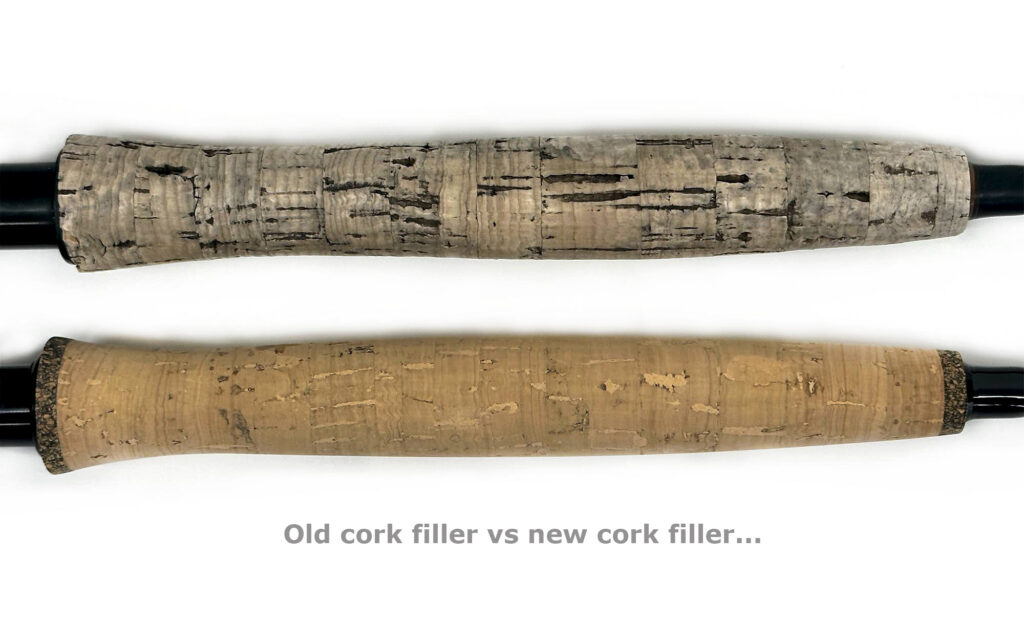
Another straightforward category – the better the grade of cork, the better the score. Manufacturers use different terms for high grade cork, describing them as “Flor grade,” “AAA grade,” or “Special grade.” Regardless of nomenclature we found subtle differences in quality, which are so close they could vary from rod to rod in the same brand’s 9’#5 model.
It was easy to see what less expensive cork looked like, which had pits and blemishes, often filled in with cork dust filler to look better. Over time however, this filler falls away from the grip leaving your rod with many pits or skinny, miniature trenches. While these pits don’t make your rod any harder to grip, over time they can cave in, especially if they happen to be where your thumb naturally sits.
All things being equal in quality of the cork rings, we also awarded .5 points for manufacturers who included a more durable section of cork composite at the top end of the cork, as well as an additional .5 additional points at the bottom of the cork. Rods are getting expensive, and if they are to be true “heirloom” rods that can be passed down for generations, the cork has a better chance of remaining unchipped with these cork composite end-caps. Unless you have no hook keeper and are sticking your fly near the top of your cork grip it is usually the bottom end that chips the worst.
We scored the Sky G a 10 here because the cork quality was very good and both ends were capped with cork composite to eliminate chipping. Although the Asquith has no composite on either end, the thin cork rings seemed a notch above the rest and we could not deny them a 9.5. The NRX+LP and NRX+ have nearly as good cork, plus they utilize cork composite on the bottom end. The Marksman, Helios F, Helios D, R8, Aydon, IMX PRO V2, all had excellent grade cork, but all without cork composite on either end. Cork quality seemed to drop off quickly from there. Both the DXF and Aetos utilize cork composites, but the quality of their cork rings was not good, each with lots of filler. The Clearwater had less filler but no cork composite.
Here we focused on the functionality of each reel seat. Our preference was for two locking rings rather than a single locking ring. Aside from the Asquith, which has a phenomenally positive single locking ring we have found two locking rings are better than one to securely fasten your reel to prevent slippage. We prefer the upper lock ring to be thicker, and the second lock ring to be thinner.
We examined how the reel foot sits in the reel seat. Is it obvious where it fits and once you crank down the rings does it stay put securely or wiggle a tiny bit? We considered how thick or thin are the threads. If too thin will mud, dust, and grime get in the way when it is time to remove your reel? Especially if you keep it attached to your rod and in a rod vault most of its life.
We gave the Scott Session the only 10 in this category as we felt the double lock rings were smooth as butter but also very positive when locking down the reel to the rod. While the hood rotates, we found it very easy to find where to put the reel foot. There were other standouts, including the Asquith, NRX+LP, NRX+, IMX PRO V2, and the Douglas DXF Gen 2.
The Asquith, only had one lock ring but was one of the best at gaining a positive lock and also had serious knurling for a grip to twist it tight. The other G. Loomis rods all had great lock rings and were easy to use as well. Functionality wise, we liked the DXF Gen 2 reel seat more than the Sky G, with its excellent lock rings and ease of use.
The Helios rods were easy to use but only had one lock ring which was not as smooth as others going up and down the threads. The Hardy Marksman lost points as it was not as easy to fit the reel into the reel seat without looking closely – which also made things tough since it is a black reel seat. The sliding hood also wasn’t very thick, which made it slightly difficult to seat the foot on the bottom end as well. The Guideline NT11 lost a point or two because it only had one lock ring, with very thin threads. The hood on the Grey’s Lance barely fit our reel seat and although it had two locking rings did not tighten well – even when fully tightened the reel seat wiggled back and forth.
Here we graded the reel seats as seen as art. Was the reel seat stunning and made from appealing or attractive materials? Did the reel seat stand out and make you desire the rod more (or less)? Does the reel seat include a classy wood insert spacer or a cool skeletal design? Obviously, this was another subjective category which not all will agree with.
We gave the Asquith the only 10 here. If you are used to Lexus steering wheels you will recognize the bamboo utilized in this insert. The threads are perfect, the hood has attractive cutouts, the single locking ring has excellent knurling, and even the butt cap has the engraved “fear no fish” logo.
Lots of excellent reel seats to follow that all scored 9’s. Some of our favorite looks include the Sky G, Scott Session, Hardy Marksman, NRX+LP, NRX+ and IMX PRO V2. The DXF 2’s “murdered out” all black reel seat was cool but seemed more fitting on a saltwater rod. The NT11’s wood insert looked nice but the metal hardware was pretty plain. The Fenwick Aetos added a carbon fiber insert but still had an inexpensive look to it. The Grey’s Lance and Clearwater had the least character, with similar solid metal and no contrasting lines to speak of.
Here we take a close look to see how well are the guides wrapped and how nice are the epoxy coatings? Nearly everyone is using one-coat epoxy coatings over the guide wraps now. If they are not carefully applied, they are often sloppy and add unnecessary weight, especially if the epoxy globs are closer to the tip of the rod.
We gave the G. Loomis Asquith the only 10 although the Scott Session and Hardy Marksman were close at 9.5 each. The Sky G was also very good, as were the NRX+ rods and the Guideline NT11. The others were satisfactory, but the Sage R8 still had the bulkiest coatings.
Nearly all manufacturers offer some kind of limited “Lifetime Warranty.” In part, this is why rods have become as expensive as they are. Manufacturers expect a certain percentage of rods to come back broken, whether by defect or broken in a car door. Knowing they will have to deal with these broken rods (usually just the tip) they pad the purchase price to help pay for the materials and labor that they will eventually have to supply.
Some manufacturers refer to their fee as a warranty fee, others are charging an associated “handling fee” or “shipping fee” to repair or replace a broken rod. Additionally, it will cost you around $10-15 to ship your rod in for repair, or have your local shop do it for you. Some manufacturers only require a photo of the broken rod piece, which helps save time and money since you are not required to send your broken rod or section in. For this Shootout, we have re-checked each manufacturer’s warranty policy in detail as many have changed slightly over the years. You can read our summary of each manufacturer’s warranty policy below.
We have awarded scores prioritizing the lowest repair charges and quickest repair turnaround times. If your favorite rod breaks at the start of the summer and you don’t get it back for two months you are going to be very angry!
Some manufacturers no longer allow retail stores to handle repairs, which is frustrating for both consumers and fly shops. G.Loomis has taken the lead on this, and will not allow a dealer to handle a customer’s rod repair. Instead, customers must register their rod online, and supply a credit card to cover the repair fees. Not only does this allow the manufacturer more visibility, (as they can now bomb the customer’s inbox with spam e-mails, closeout discounts, and brand awareness), but it may even cut down on repairs, (as some customers may give up on dealing with the repair process entirely), opting to purchase a new rod instead.
We took all of this into consideration when scoring each manufacturer’s warranty policy. To get a 10, repair charges had to be $65 or less, not require you to send in the broken rod, (sending in a photo of the broken section(s) will suffice), and have a turnaround time of roughly one week or less. Most rated between 8.5 and 9 with an average fee of $75 and an average of 3-4 weeks turnaround time. Orvis only offers a 25-year warranty, however we feel this wasn’t a huge deterrent since most serious anglers will have the latest and greatest by year 2049. We dinged Sage down to a 7.5 as some of their legacy rods are more expensive to fix, but mostly since Sage’s turnaround times take 2-3 months. A real bummer should you happen to break your rod on June 20th. Fenwick received our lowest score at 6.5 as they now only offer a 5-year warranty, and if you break a rod, (due to the angler’s fault), the rod is replaced at 45% discount. After that, no future warranty is allowed, (unless your replacement rod has a true manufacturing defect). Ouch!
We got the idea for this category years ago from the Car and Driver automobile Shootouts. Now that we have eliminated our “Perfect 5” category, this category gives you our opinions on the best rods and how they stack up. If a rod looks like a million bucks and casts like it too, and has that certain “wow” factor, anglers are going to desire it.
Some anglers might consider a high-priced rod as a status symbol. For others, seeing how a rod performs in an expert caster’s hands convinces them it would make them a better angler as well, or at least take them up to the next level. Surprisingly, this is often true, even if it is just a boost in confidence. Great rods don’t make great casters, but there is no doubt that they will improve any angler’s casting skills.
Pick any rod here that we rated a 9 or better and you have a real winner! We gave out 10’s to the Sky G, Asquith, Marksman, and NRX+LP. All of these rods were in almost every tester’s top four. They are all perfect 5 weights, each with subtle differences in feel, power, swing weight, and accuracy. While G. Loomis and Hardy have better marketing and brand recognition than Douglas, we just couldn’t deny the Sky G a 10.
We gave the NRX+ a 9.8 as it performed best at 45-60 feet and was likely too powerful for most anglers. Still, for long bomb assassins, this is the one! The Helios F was on the other bookend, being one of the softer rods in the Shootout. This could be the rod for the dry fly angler! The Helios D and Sage R8 felt nearly identical and were stiffer with less feel than the aforementioned rods. Like Chevy or Ford, they both have extremely large followings and fan bases, their ads look the best in fly fishing magazines and they are the best at social media ads as well.
The NT11 and Aydon got the highest Mid-Priced rod scores, each with a 9. The NT11 is so light and playful that we feel any trout angler will smile after casting it. The Aydon was not far behind, as Hardy has a little more stream cred, at least here in the USA where Guideline is not yet well known. The IMX Pro V2, DFX Gen 2, and Session all got 8.5’s, mostly due to their inherently higher swing weights. The DXF Gen 2 was lighter and felt best, but also Douglas also doesn’t have the same marketing power or brand appeal as G.Loomis or Scott. The Recon, Aetos, and Clearwater all had the heaviest swing weights in the test. The Lance had the thinnest grip and not much power, although it would be a great pick for women, children, or anyone with small hands.
Another simple category, the lighter the overall weight the higher the score. Sometimes companies know they can reduce overall weight by choosing lighter materials in the reel seat or butt section. The problem with this method is that it doesn’t make the rod feel lighter in your hand like swing weight does, hence the reason we only scored up to 10 points.
For the overall weight, we simply placed each rod horizontally on the scale, read the weight and rounded it off to one tenth of an ounce. Overall weight is certainly a factor, but the swing weight is far more important.
The swing weight of the rod is the weight you feel out ahead of your hand, holding the rod horizontally. A little wiggle back and forth helps you feel this. Rods with a light swing weight are delightful, fun, and effortless to cast. Rods with a heavy swing weight feel clunky and clumsy in your hand and are not going to be pleasant to cast and fish all day.
Since swing weight plays a large role in how a rod feels in your hand and also performs, we raised the points available in this category to 20 points. Using our method of finding the swing weight, the Sky G was the winner. The Asquith, Marksman, Aydon, and NT11 were close. Heavier rods included the Recon, Aetos, and Clearwater.
A rod’s ability to make delicate and accurate presentations using small flies and a 12’ leader are the keys to scoring well here. Casting accuracy is one of the biggest factors we use in rating each rod at 25’. The feel you get through the cork handle imparts feedback which leads to confidence, allowing you to put the fly exactly where you want it. I’m convinced the key to catching more trout and especially larger trout is casting accuracy with a delicate presentation. Fly selection is important, but if you slam the correct fly on top of a big spooky fish, the game is over immediately.
Does the tip load well enough in close, to give you the feel and accuracy you need with only the leader and very little line out of the guides? At short range I like to cast off the tip of the rod, using mostly my wrist and very little arm movement to power the tip of the rod through the stroke. The best rods in this category are almost always the lightest in swing weight, since you are doing a lot of false casting while fishing dries.
The best all-around 5-weights need to perform exceptionally well at short distances. 90% of the dry fly fishing I do is at distances between 25-45 feet. The rods that scored 19.5 or better here are the ones to consider.
35 feet is a new testing distance for us. While casting various rods on the lawn beside our shop, we decided to cast at a distance that felt “normal” to us when we were targeting rising fish. What we realized was that everyone was casting around 33-38 feet – a distance that we have not scored in our previous Shootouts.
At 25 feet, it is more difficult to feel the rod load since very little line is out of the rod tip. A few rods still do this quite well, which became our favorite rods. We found at 45 feet accuracy can become more difficult, especially when there is any wind. Even a 5 mph side wind can blow you off target, and if a gust of 10-12 mph blows through it can be enough to throw your fly several feet off center.
35 feet just felt like the perfect distance to load the rod well and make an accurate cast without spooking the fish. When fishing, 35’ is also a good distance to manage line as mending is easy to control. At this distance you have just the right amount of slack on the water to still strike quickly as needed. At 45-60 feet there can be a delay from when your brain tells your hand to strike, and when the fly actually moves as a result.
The Sky G, Asquith, Marksman, and NRX+LP were the standouts here, each earning a perfect 20. The NRX+, Helios F, R8, Aydon, and DXF Gen 2 were not far behind, each scoring 19.5.
The best all-around 5-weights need to be able to perform well at 45 feet. Ideally, if a fish moves outside of 35 feet, an angler can reposition to get a little closer. But sometimes that isn’t feasible. Perhaps the angler has sneaked in low and on his or her knees, making it harder to move up. Perhaps they are fishing a tailwater and moving forward in the shallow water will send warning rings to trout’s lateral line. If a rod can be accurate at 45 feet there is no need to move.
At 45 feet a 5-weight rod needs to be light and pleasant enough to do a lot of false casting, as you will when fishing dry flies all day. Rods that throw a stable loop at 45 feet will also be good at throwing larger wind-resistant dries like chubbies and hoppers. Getting your leader to turn over a fly in 20 mph wind requires a rod that is capable of giving you extremely tight loops. Or, if the fish are not rising well to the surface, it is nice to have a rod with ample power to add a tungsten bead dropper.
The best 5-weights will have excellent loop control at 45 feet and not require a double haul (unless you are casting into a brisk headwind). They should also be able to open your loop if you happen to be fishing two nymphs under an indicator. We have found the rods that seem the most capable of doing all of the above are nearly always the faster action rods.
This year we didn’t give any perfect 20’s. I suppose some of this had to do with adding the 35’ distance, but I didn’t feel any of the rods were absolutely perfect. This is actually something I prefer however, as I value a higher scoring rod in close. If a rod was perfect at 45 or 60 it would by nature be less effective at 25-35 feet.
The G. Loomis Asquith was nearly perfect and at 19.8 was closest to a true 20. It was very light in hand, and exceptionally accurate. The Sky G, Marksman, NRX+LP, Helios F, Helios D, and R8 were hot on its heels at 19.5.
This year we reduced our longest distance from 70 feet to 60 feet. We felt it was easier to judge accuracy at 60 feet as 70 feet is more of a hope and pray distance. Rather than back our 70 feet category down to a maximum of 10 points we decided to go with 60 feet and keep it at 20 points available. We also felt most people won’t be casting at 70 feet, so our Shootout might be more useful to them at a more reasonable distance.
We don’t often ask a 5-weight to cast 60 feet and beyond, but the best rods can certainly do it well, especially with an expert caster at the controls. But this also requires an angler to double-haul well with good form.
There are not many instances that call for this kind of long-range casting, but we value this distance category as the rods that handle longer distances best also handled the wind better, as well as fishing smaller streamers the best.
Sure, a 6 or 7 weight rod would be better suited to get the job done fishing streamers, but a good 5-weight works surprisingly well as long as you limit your streamers to smaller sizes that utilize materials that don’t soak up a ton of water.
With a great all-around 5-weight you can say goodbye to the years of bringing along two rods (one for dries and one for streamers).
While we didn’t score any rods a perfect 20 at 60 feet, here the NRX+ was the king. Even when compared directly to the other stiffer rods it was a lighter and better rocket launcher. The Asquith, Marksman, and R8 were close, but the NRX+ was truly on a level of its own. The Clearwater had plenty of power to cast 60 feet but was unpleasant to do so because of its heavy swing weight, scoring a 17.5. The Scott Session, which I liked much better in close, was too soft in the mid-section to consistently generate accurate casts at 60 feet, scoring only a 17.
We have here summarized the latest warranty policies of rod manufacturers and our experience with repair turn-around times. Before you purchase any rod, check the manufacturers for updates to their warranty policies as these often change. Click on their logo or name to see each manufacturer’s spiel in detail.

Douglas – No fault, lifetime warranty for original owner with proof of purchase. A $45 fee (per damaged section) plus a $20 shipping and handling fee inside the continental US. You do NOT have to send your broken rod to Douglas, instead fill out the on-line form, take a photo of your broken section(s) and Douglas will ship you a replacement in less that 7 business days.
Go to: https://douglasoutdoors.com/warranty/ to start this process.
Contact Info: 1-315-695-2000
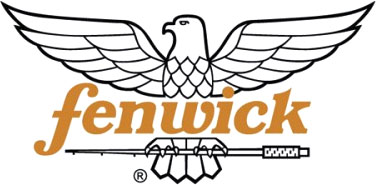
Fenwick– Fenwick now offers a 5-year warranty for all rod models. Proof of purchase is required. Fenwick will replace the broken rod with a new rod. There is a $9.95 processing fee for rods broken while actively fishing. If the breakage is the fault of the angler (car door, stepped on, etc.) the rod will be replaced with one at a 45% discount and no further warranty. (If a true manufacturing defect is found in your replacement rod it would still be covered), but for angler-fault accidental breaks, the second time around the 45% discount option is no longer available. Usually takes less than 2 weeks.
You no longer have to send your rod in for repair, instead simply take a photo of your broken section(s) and send it to support@fenwickfishing.com. Click here to register your rod: https://register.fenwickfishing.com/ .
Or, go to: https://www.fenwickfishing.com/fenwick-warranty to start this process
Contact Info: 1-(877)-336-7637 or e-mail: support@fenwickfishing.com.

Greys – You must create an account and register your rod within 60 days of purchase. Lifetime warranty for the repair or replacement (at Grey’s discretion). Greys asks that you send your rod in for inspection. If Greys determines that there was a defect, the rod will be repaired or replaced at no charge. Otherwise the processing fee is $35.00. Shipping is out of their US warehouse and usually takes less than 2 weeks.
Go to: https://www.greysfishing.com/warranty-policy to start this process
Contact Info: 1-(888)-516-1247

Hardy – Lifetime warranty to original owner. Hardy asks that you send in your broken rod for inspection. No payment is required if the issue is deemed to be a manufacturer fault. Otherwise, there is a $75 handling fee per section. (Editor’s note: we have noticed Hardy reducing this to a $75 handling fee per claim – for those who are kind and courteous and don’t send multiple broken rods in each year). Rods are repaired or sections replaced. Shipping is from their US warehouse, usually takes less than 2 weeks.
Go to: https://www.hardyfishing.com/hardy-warranty to start this process
Contact Info:1-(888)-516-1247

G. Loomis – You must create an account and register your rod within 30 days of purchase. Lifetime warranty to original owner. If you feel your rod has broken because of a defect, send it back. Your rod will be examined, if deemed a manufacturer defect, the broken section will be replaced with no handling fee. This option usually takes longer, 3-4 weeks.
If broken from neglect or it is the angler’s fault, (car door, stepped on etc.) use the Xpeditor service. Usually it is a tip section that breaks – if so use the Tip Program which is cheaper. Most fly rods cost $60 for a new tip, the Asquith is $75. If it is any other section than the tip use the regular Xpeditor service. Most all fly rod models cost $150, while the Asquith is $310.
If you opt for either an Xpeditor tip or regular Xpeditor service, you should have a new tip (or new rod) in less than a week. You do not have to send back broken tips (hence you could order an “extra” this way if you wanted to have a backup). G.Loomis will provide a FED-EX shipping label for you to send back your broken rod. As long as they receive your broken rod within 30 days you will not be charged the full amount for a new rod, just the replacement fee.
Go to: https://www.gloomis.com/pages/services to start this process
Contact Info: 1-(877)-577-0600

Guideline – For NT11 and NT8 rods customers are entitled to a 25 year warranty for the original owner. Sections will be repaired or replaced at Guideline’s discretion. Customers are required to send broken rods in. If Guideline deems it is a manufacturer’s defect there is no charge. For all other repairs, there is a $75 handling fee per claim. Shipping is from Guideline’s US warehouse and usually takes less than 2 weeks.
If you know the break is not a manufacturer’s defect, or you simply need a new section quickly, Guideline also offers an I-Express service, where you may purchase the exact section(s) you need from their Spare Parts on-line store. Each section costs $75.00 (which includes shipping fees) and is immediately shipped to you from the US warehouse, meaning you will likely receive it within 3-5 business days.
Go to: https://www.guidelineflyfish.com/en/rodparts
Contact Info: service@guidelineflyfish.com

Orvis – You must create an account and register your rod. A 25 year no fault warranty to original owner. $60 handling fee. Rod is repaired, or sections are replaced. If Orvis determines that there was a defect, the rod will be repaired or replaced at no charge. For new Helios, Helios 3, Mission, and the current Recon, Clearwater, and Encounter series rods, Orvis offers a new section replacement program with a 5-business day turnaround. Other repairs usually take 4-6 weeks.
Go to https://www.orvis.com/fly-rod-repair.html to start this process.
Contact Info: 1-(800)-548-9548

Sage – All Sage rods are covered under a lifetime warranty to the original owner. The warranty covers any defects in materials and workmanship, but does not cover direct, indirect, consequential, incidental, or any other type of damage resulting from use of the product. Rods that are broken or damaged due to normal use (examples: tip break due to high sticking, fly strike breakage, shut it in the car door, etc.) are subject to a repair fee. Click on the repairs-pricing link for an update on the repair fees. These fees cover the repair of the broken rod, in addition to the shipping back to the customer. Turnaround time usually takes 10-12 weeks.
Go to https://farbank.com/pages/warranty-repair-policy to start this process.
https://farbank.com/pages/repairs-pricing
Contact Info: 1-(888)-848-7243 or 1-(206)-842-6608

Scott – Lifetime, no fault warranty to the original owner. $65 handling fee per claim, (not per section). Customers are required to return the entire rod. Broken sections will be rebuilt to match the original rod if they cannot be repaired. Usually takes 4-5 weeks.
Go to: https://www.scottflyrod.com/warranty to start the process or click here to download the repair form: Repair Form.
Contact Info: 1-(970)-249-3180 or info@scottflyrod.com
As always, we feel it is best to cast a rod before you purchase it. We cordially invite you to stop at our shop and do your own rod comparison right here on our lawn. We have several reels rigged with the various line sizes, and leaders, all ready to go to complete your own “mini-shootout.”
We realize many of our readers have a trusted fly shop near them, and likely have a good relationship with the staff. We encourage you to swing by “your” fly shop and try a few rods there if you can, and if you like a rod, purchase it with them. We would rather see you support your local fly shop than order a rod directly from the manufacturer.
However, if your fly shop doesn’t carry the rod you are interested in, (or perhaps they have been mean to you), we would love to have your business. Any purchase, large or small, helps us keep the lights on, and we appreciate it!
Use this link to go to our Favorite Freshwater Outfits where you will find our favorite rod and reel combinations. Here you’ll find our recommendations in three price ranges: The High-End Outfits, Mid-Priced Outfits and best Inexpensive Outfits. All of these outfits will come to you fully rigged, (with backing, line, leader, and even a yarn indicator for practicing on your lawn). As soon as you get your package in the mail you can immediately put your package together and go practice on the lawn, or better yet – cut the yarn off, tie on a fly, and go fishing! If you are looking for that perfect saltwater outfit, then check out this link for our Favorite Saltwater Outfits.
This year, instead of packaging only the winning rod with a reel, we have made 4 High-End 5-weight outfits to choose from, as well as 2 Mid-Priced outfits, and 2 Inexpensive outfits. If you are getting one of our High-End Outfits, we’ll throw in a free line, (the same line that we tested the rod with, which was the manufacturer’s recommendation). For Mid-Priced and Inexpensive outfits, we’ll give you the line at cost and we’ll also ship it to you for free, and since we are in Montana you pay ZERO SALES TAX!
Once you get your new rod or outfit, do some casting on the lawn, and if you feel it is not just what you want, (and has not been fished and it has not exceeded 30 days from your purchase), we will allow you to return it to us for a full refund, less the return shipping charges.
If you are not in the market for a 5-weight right now, we suggest reading one of our current Shootouts for the line size rod you want. You’ll find these on our Yellowstone Angler home page under reviews.
Or you can call us at 406-222-7130, or e-mail us at staff@yellowstoneangler and we can discuss your needs and wants. I’m confident that we can come up with the perfect rod or outfit for you.
George’s Signature –